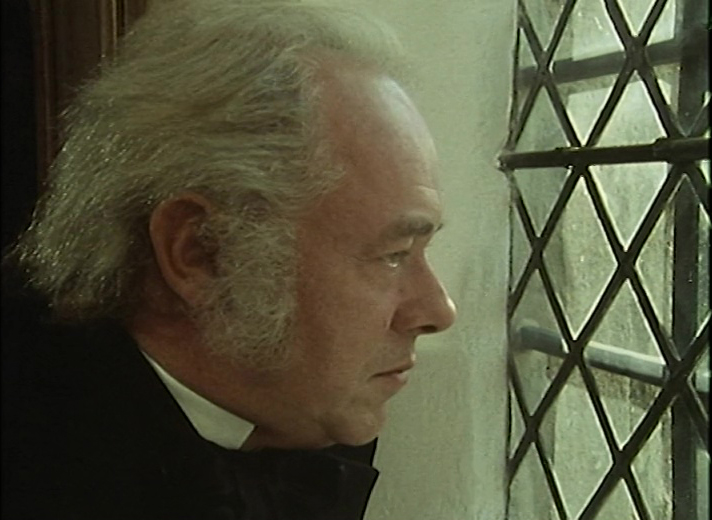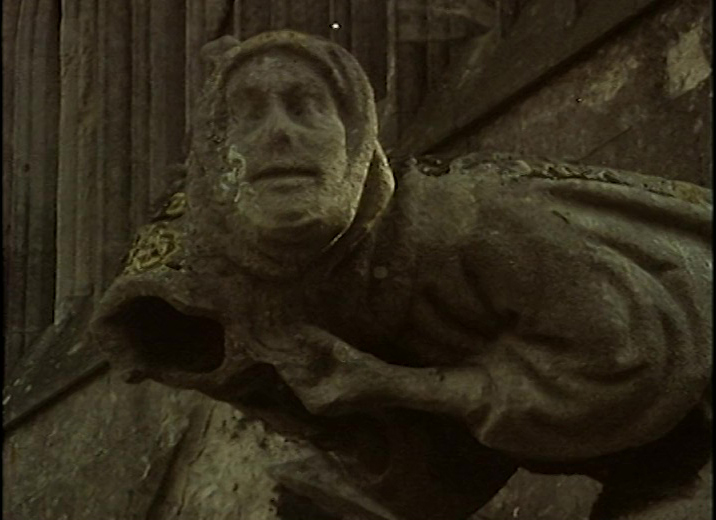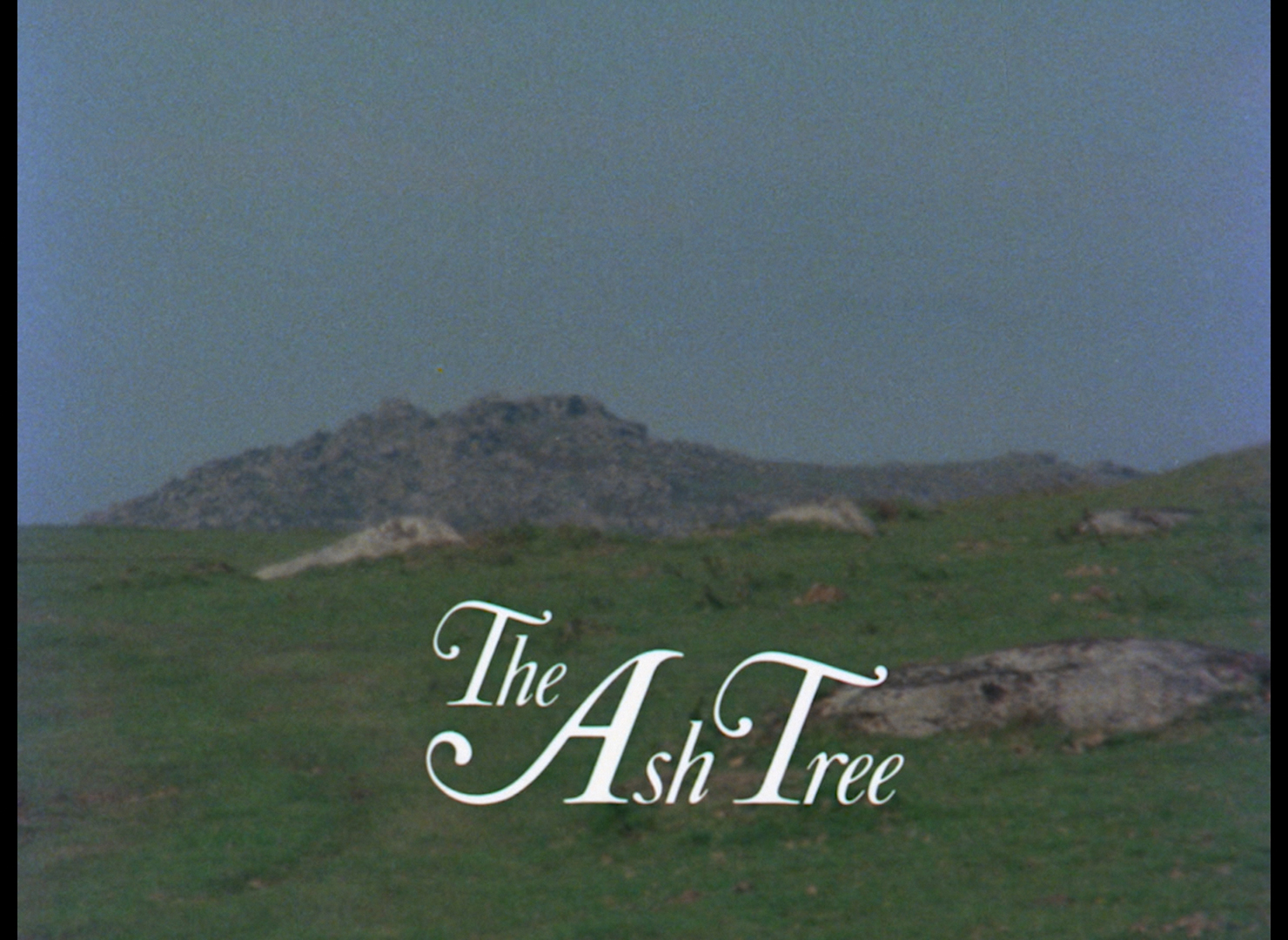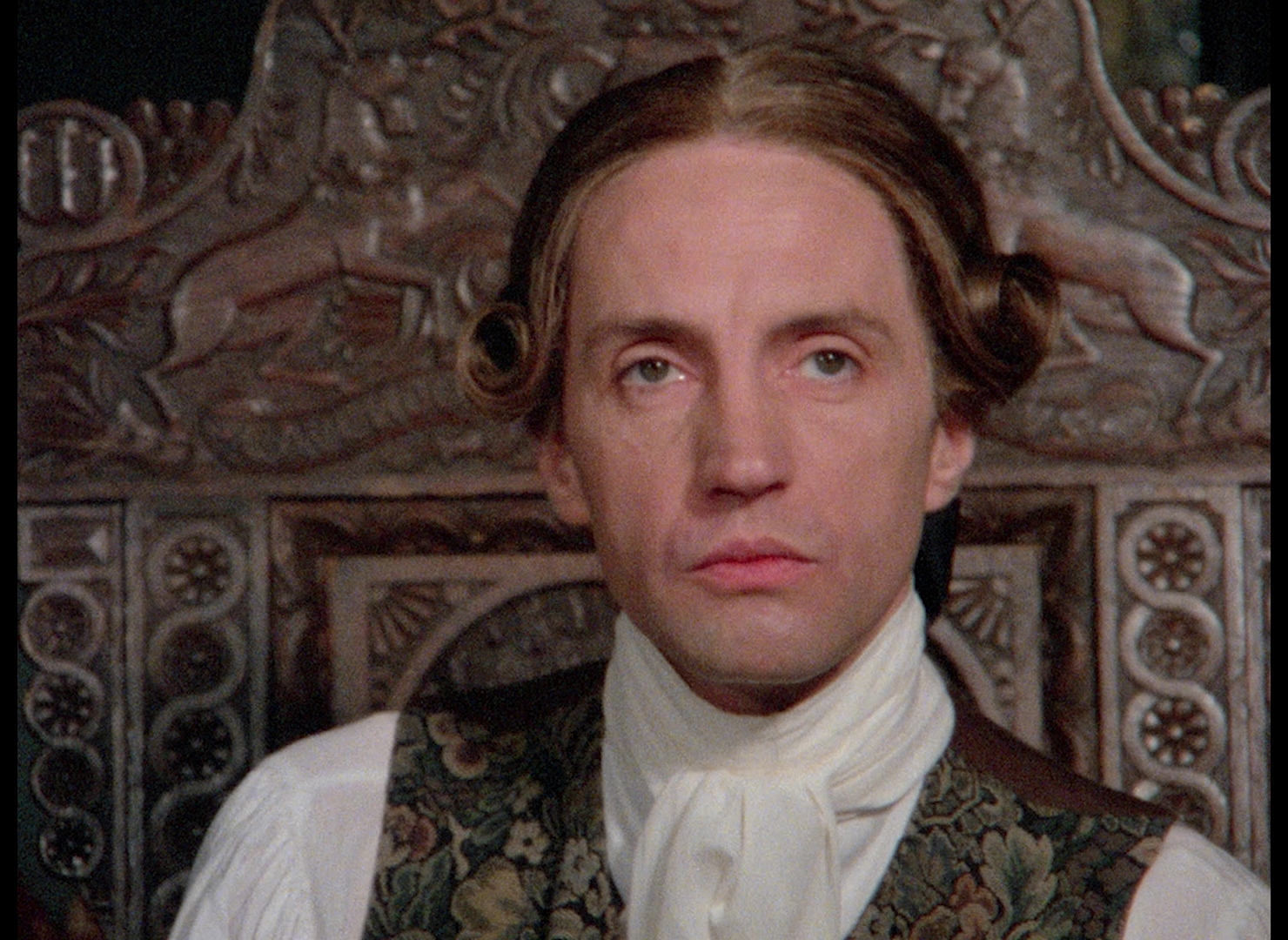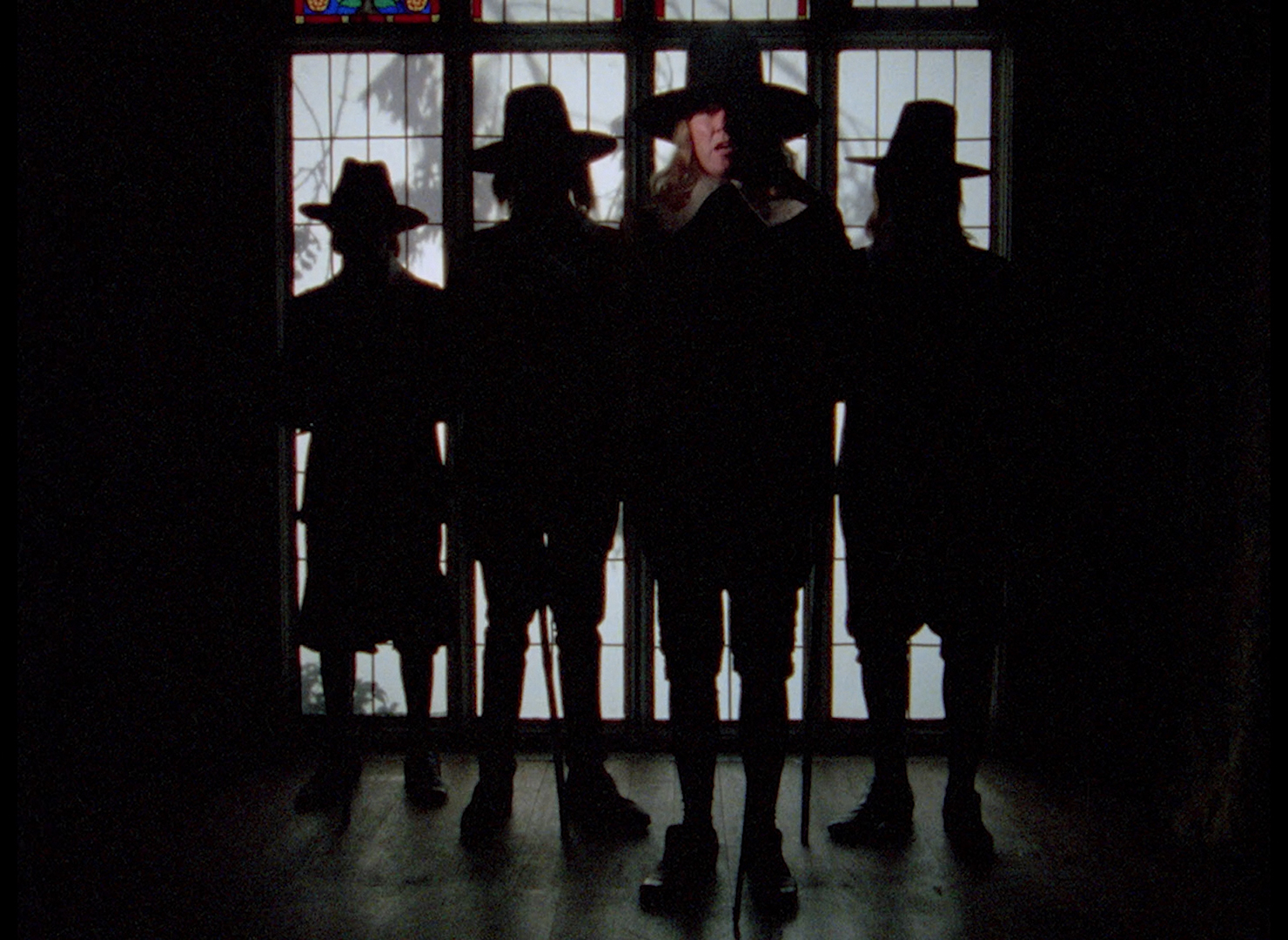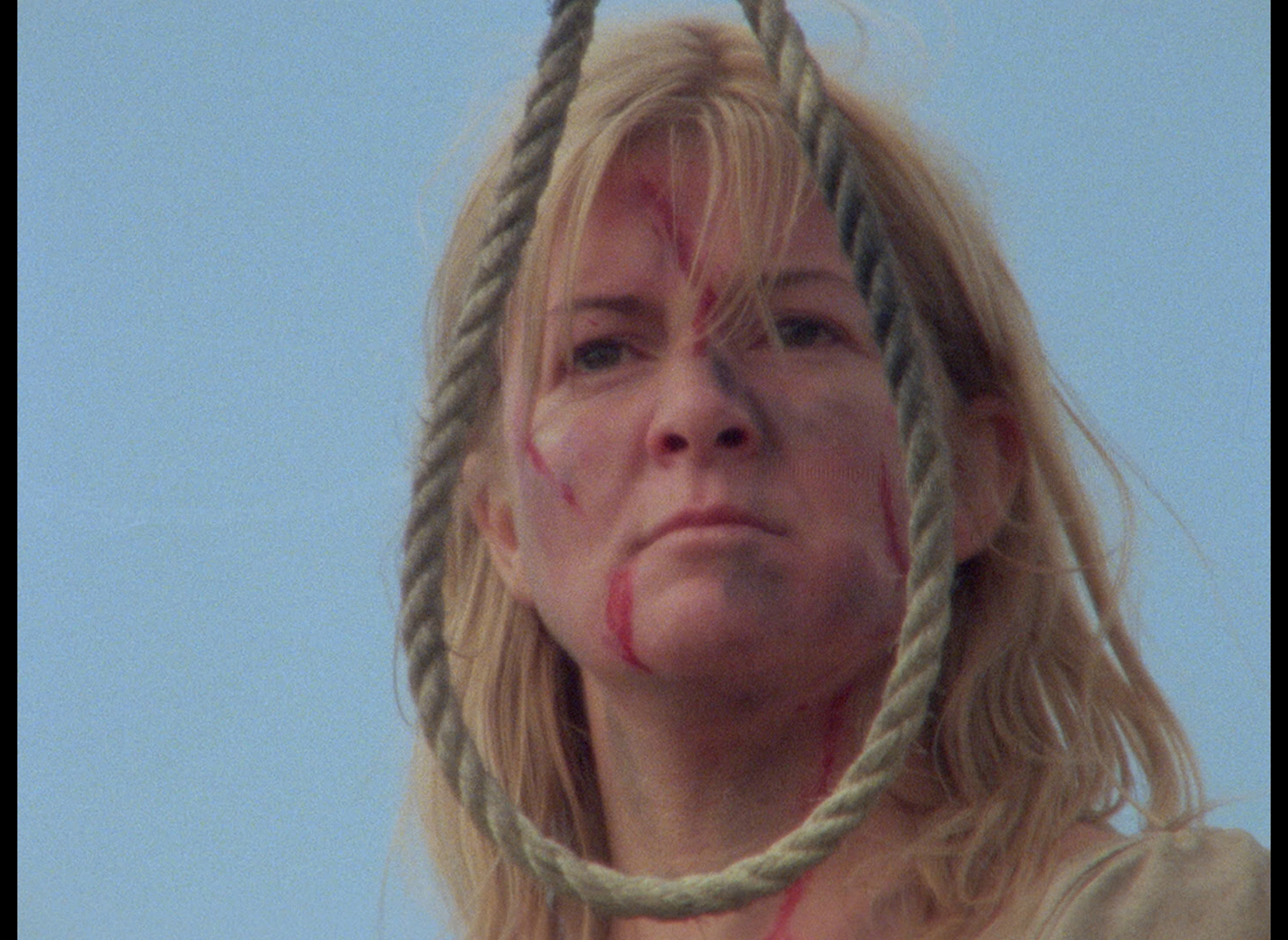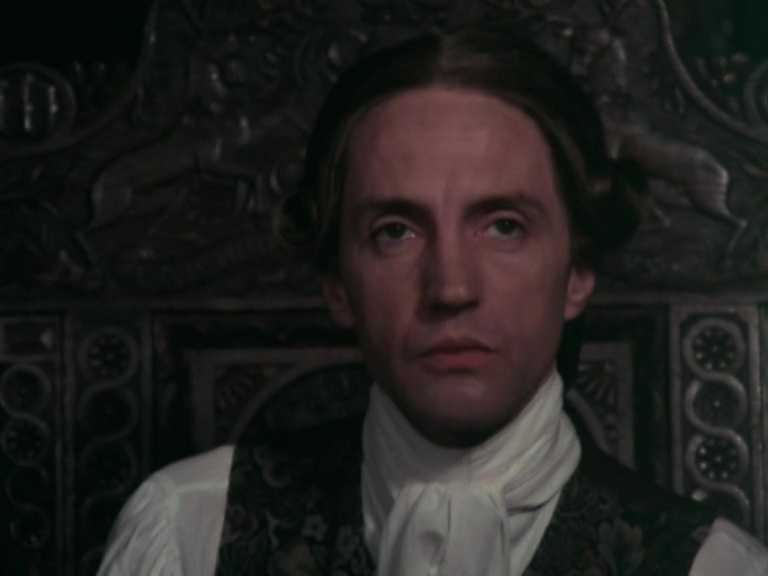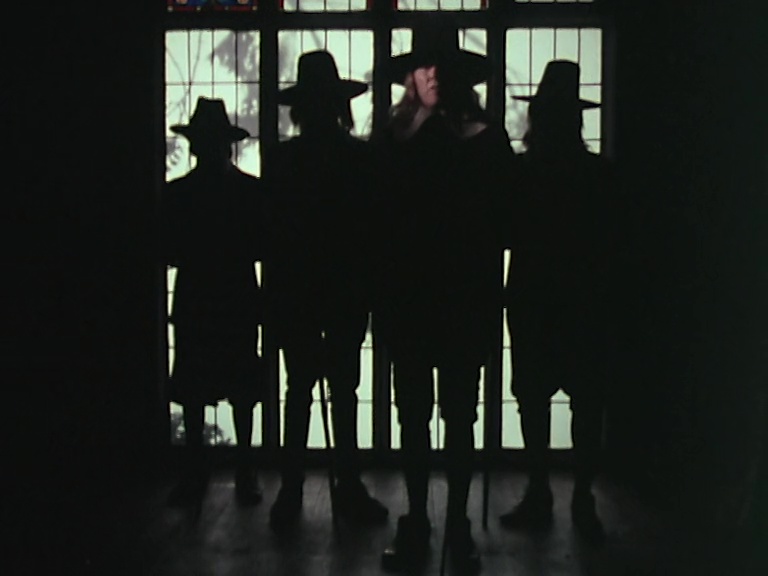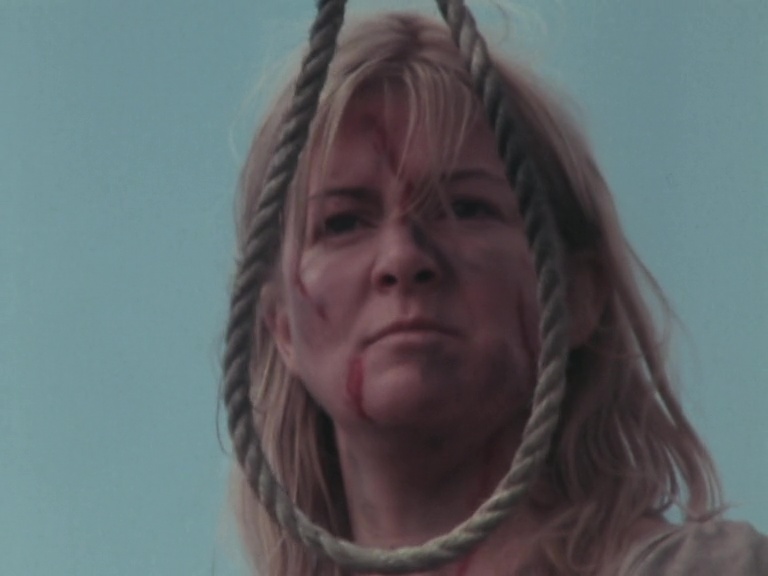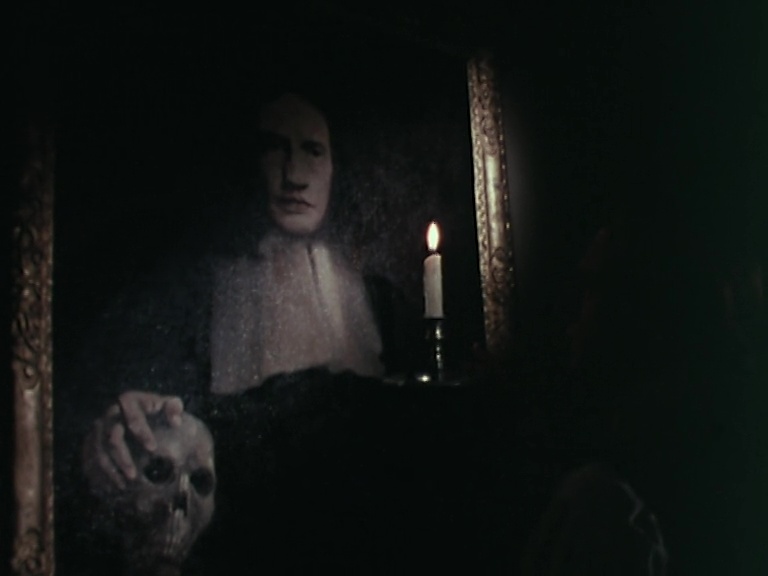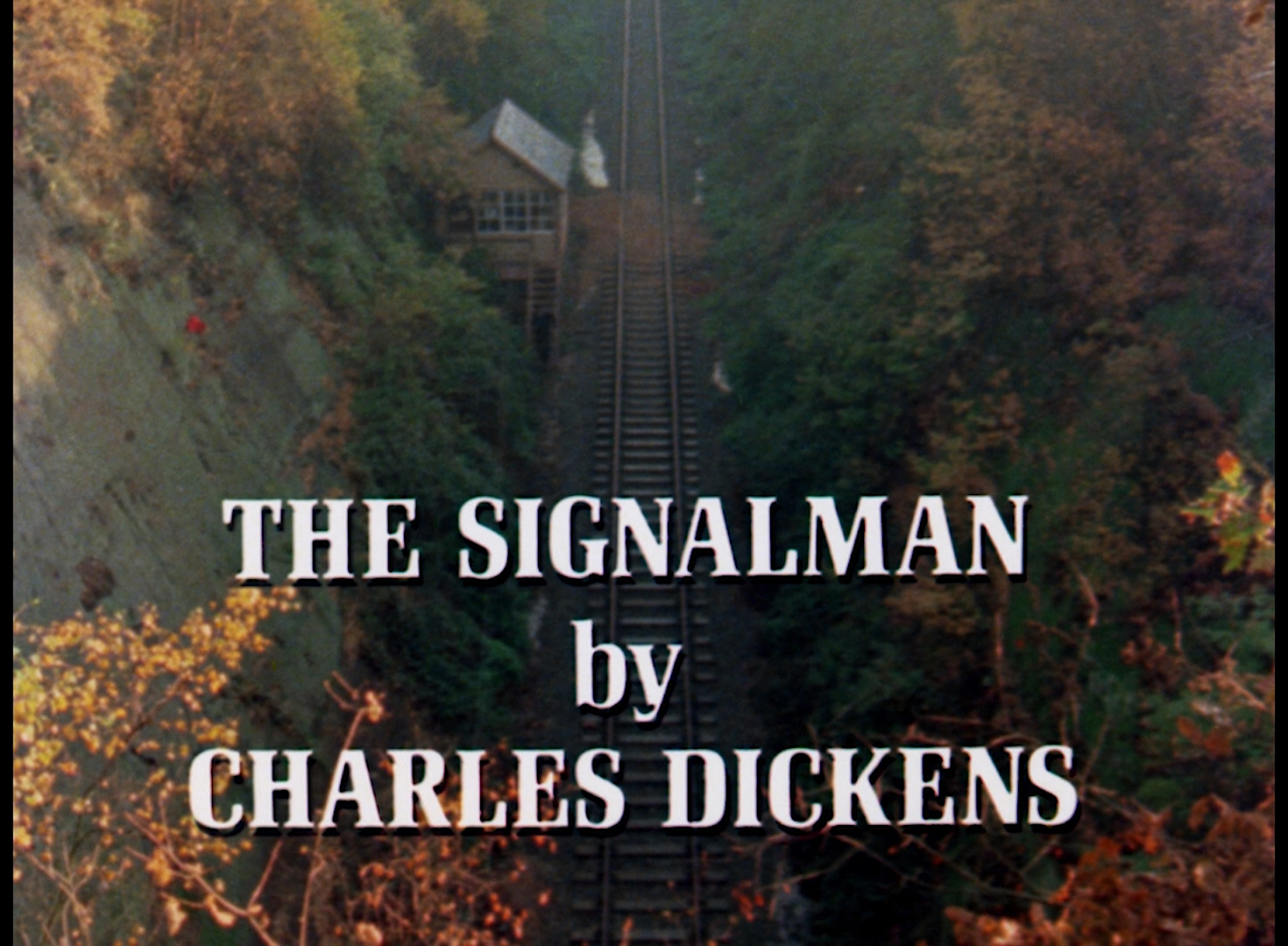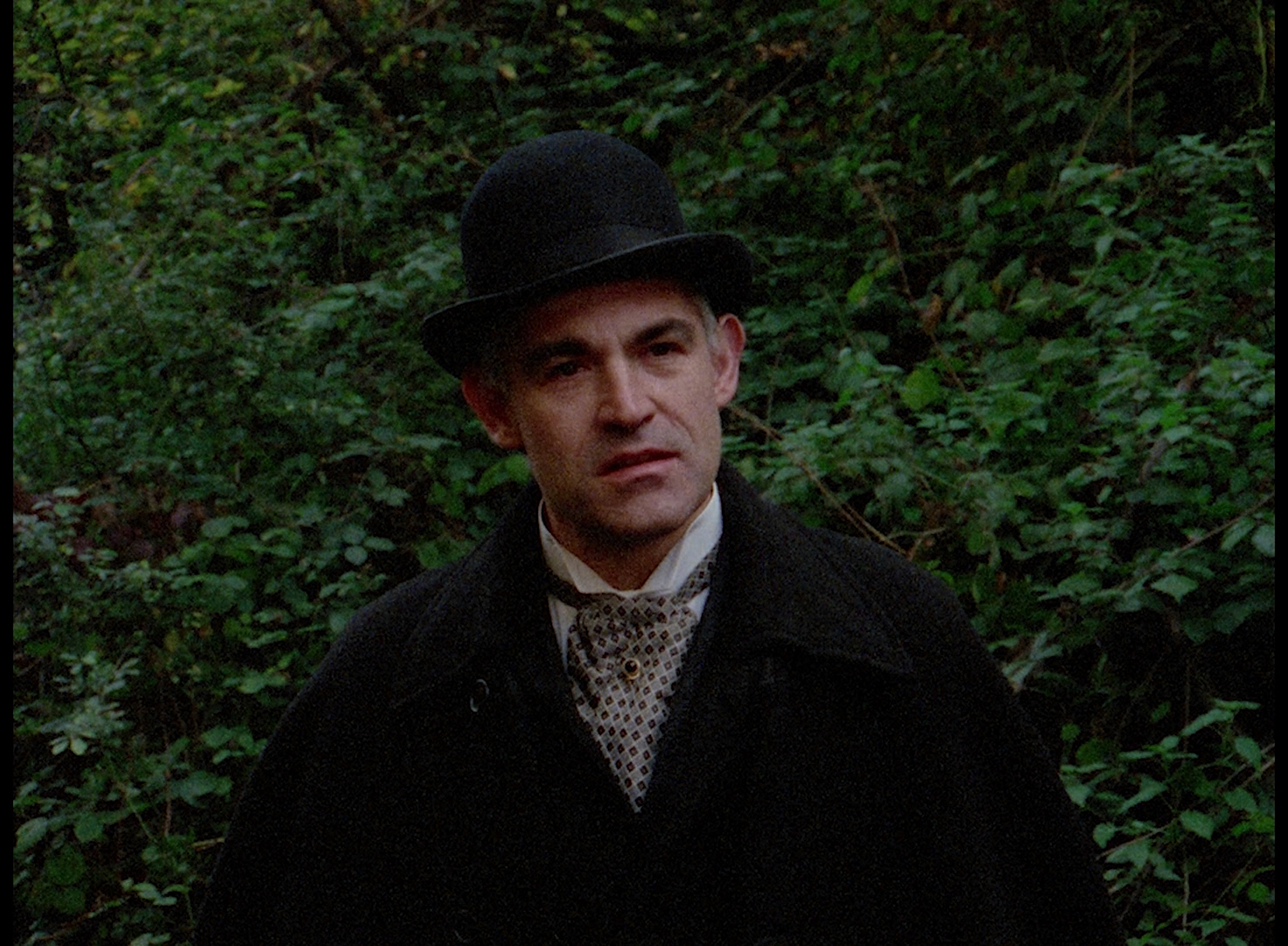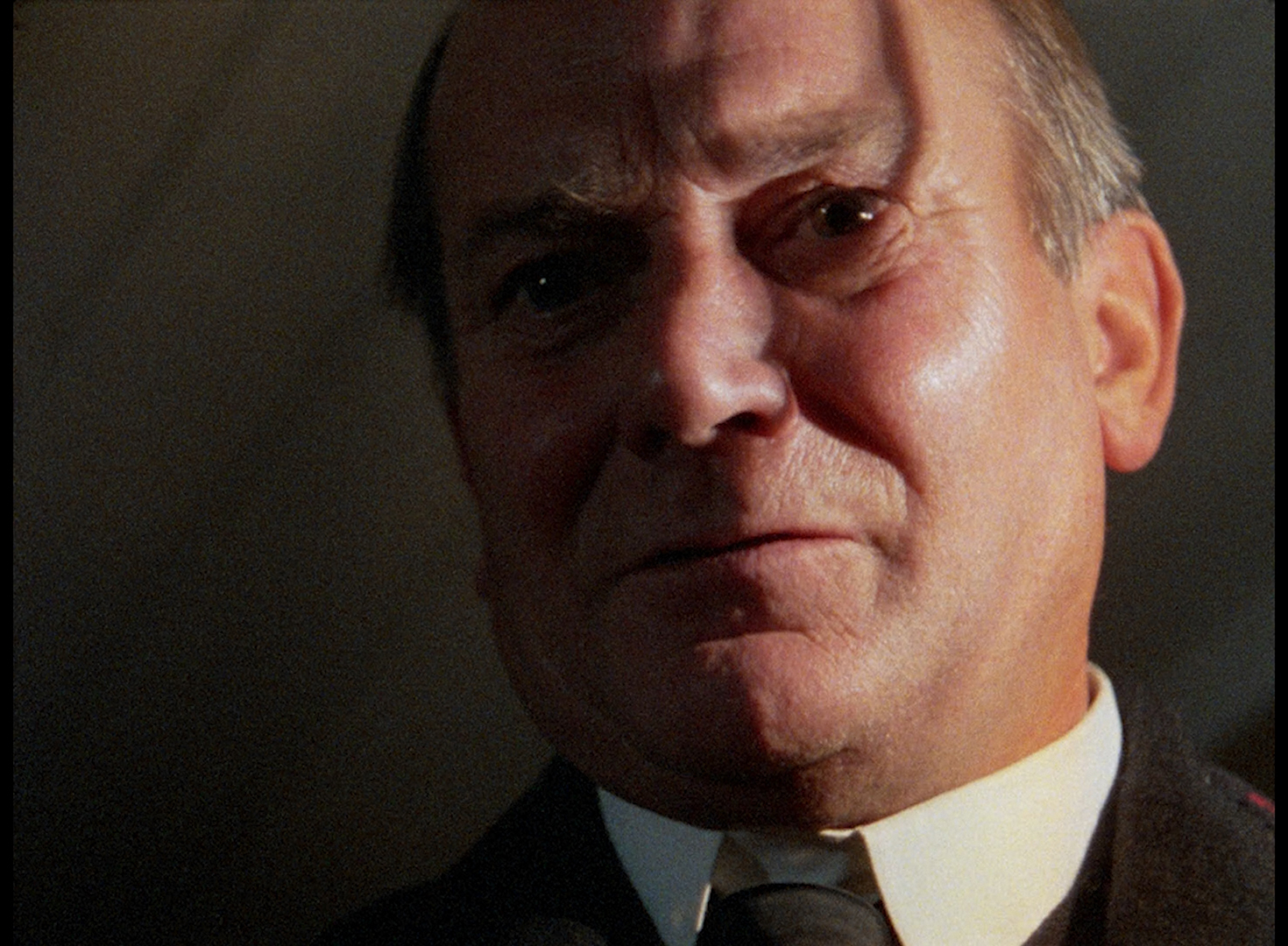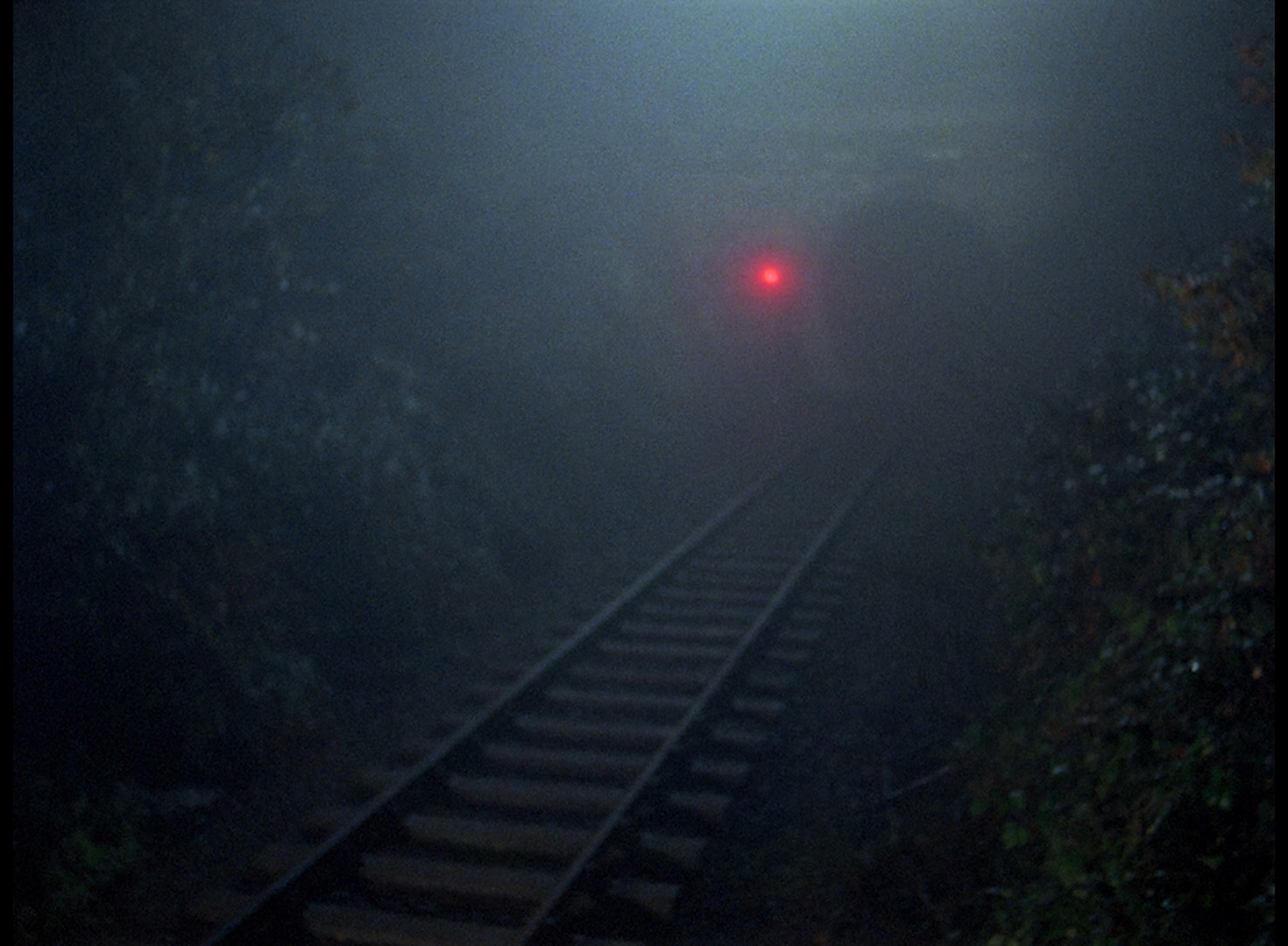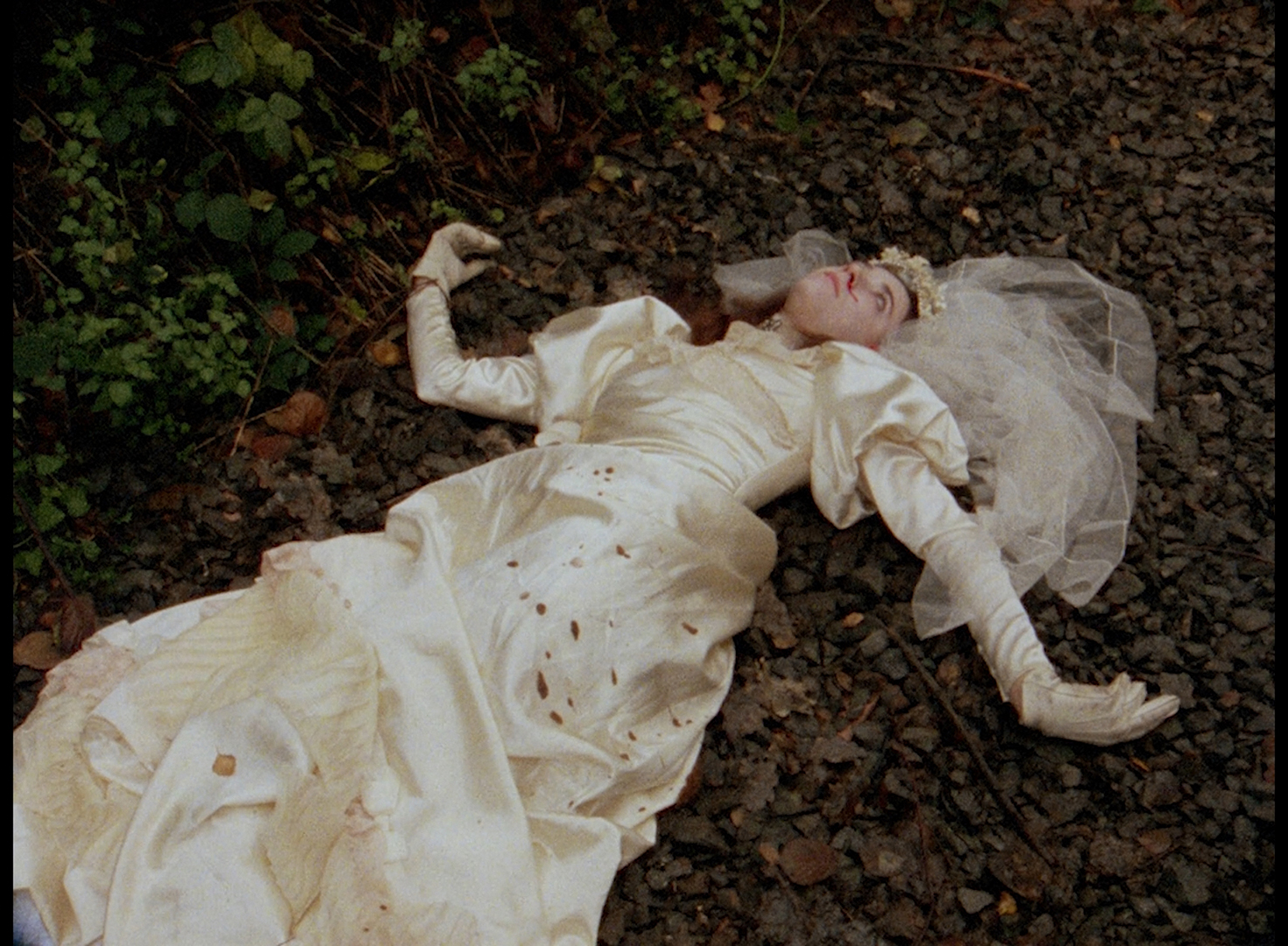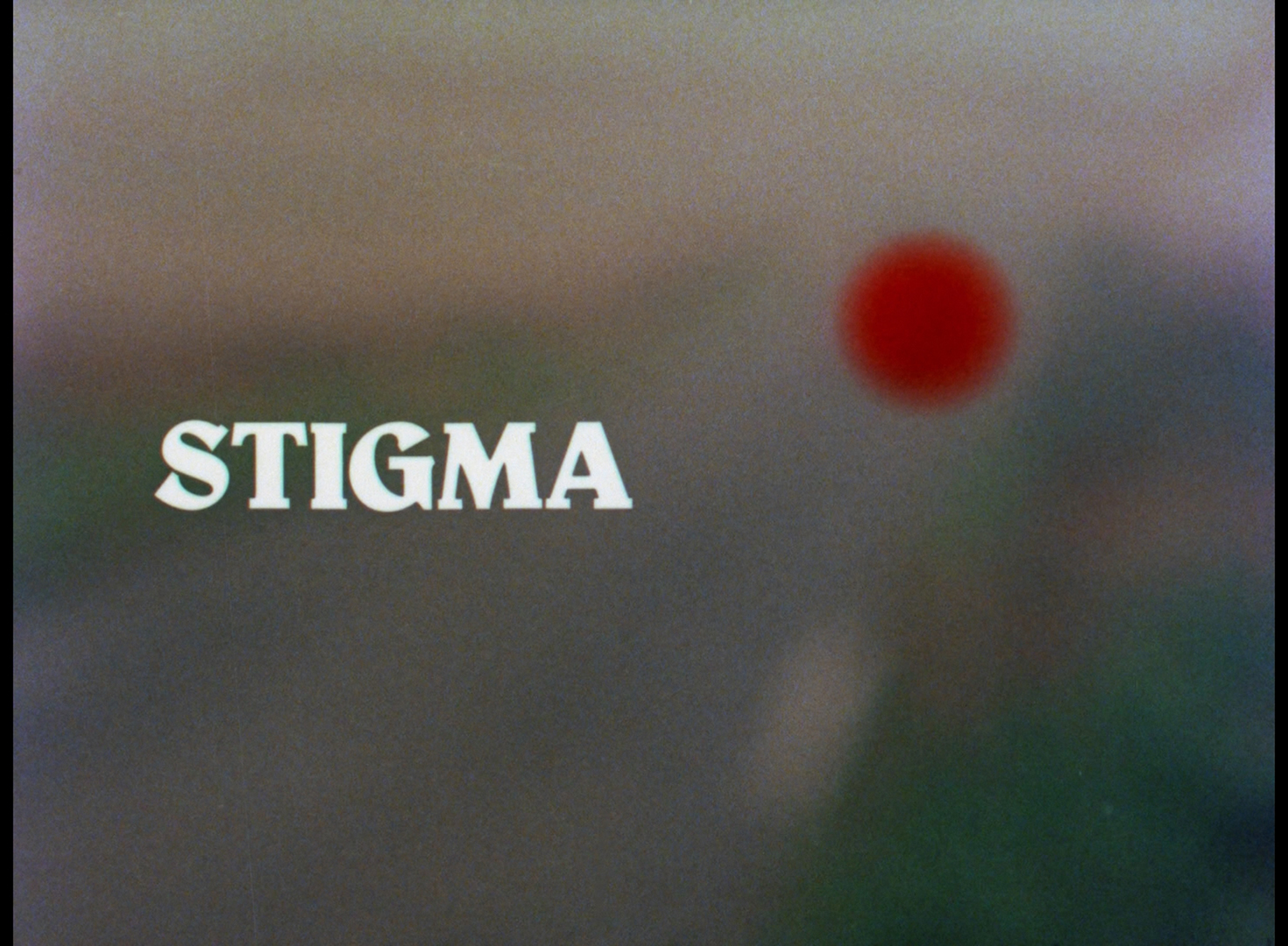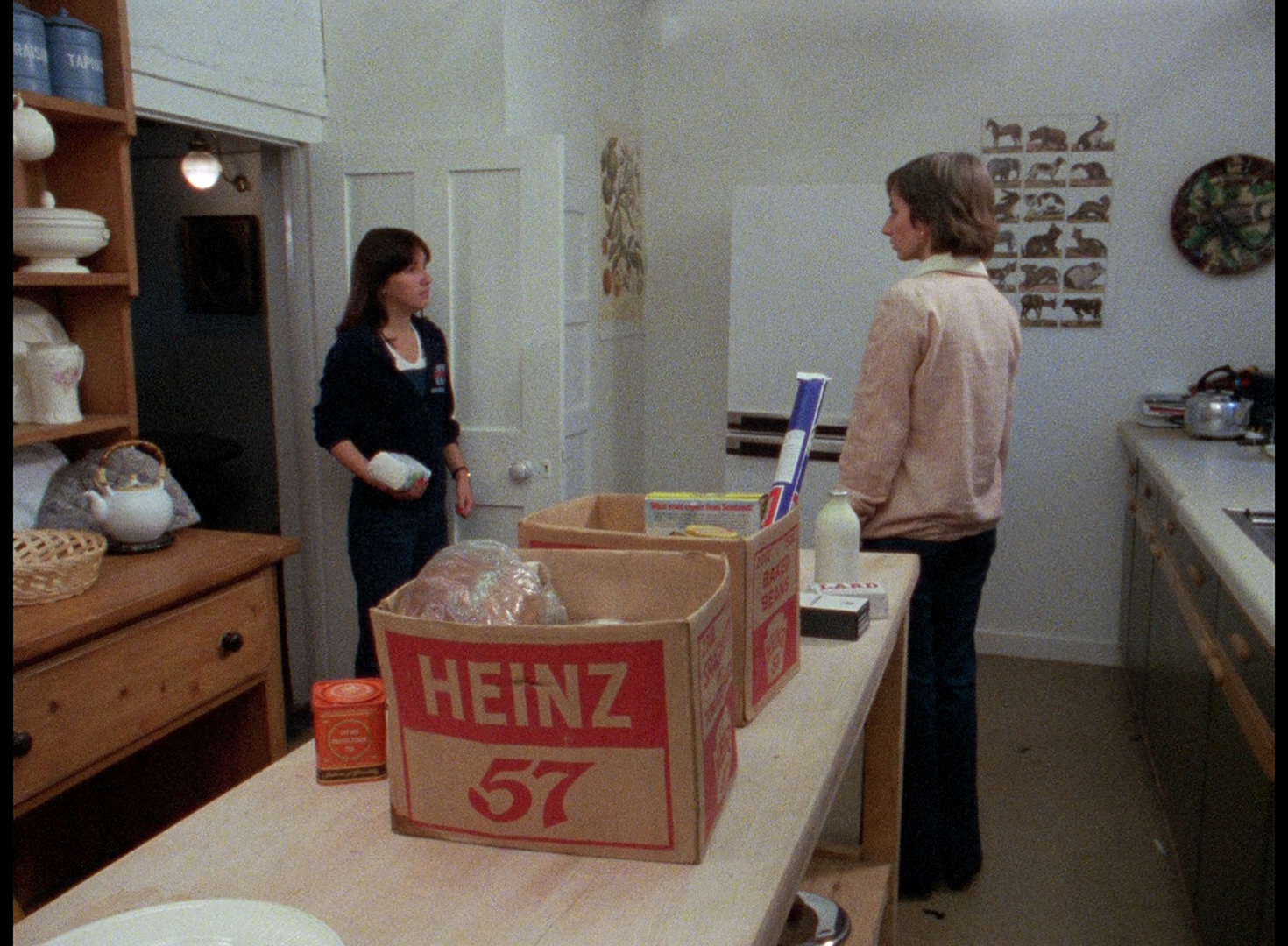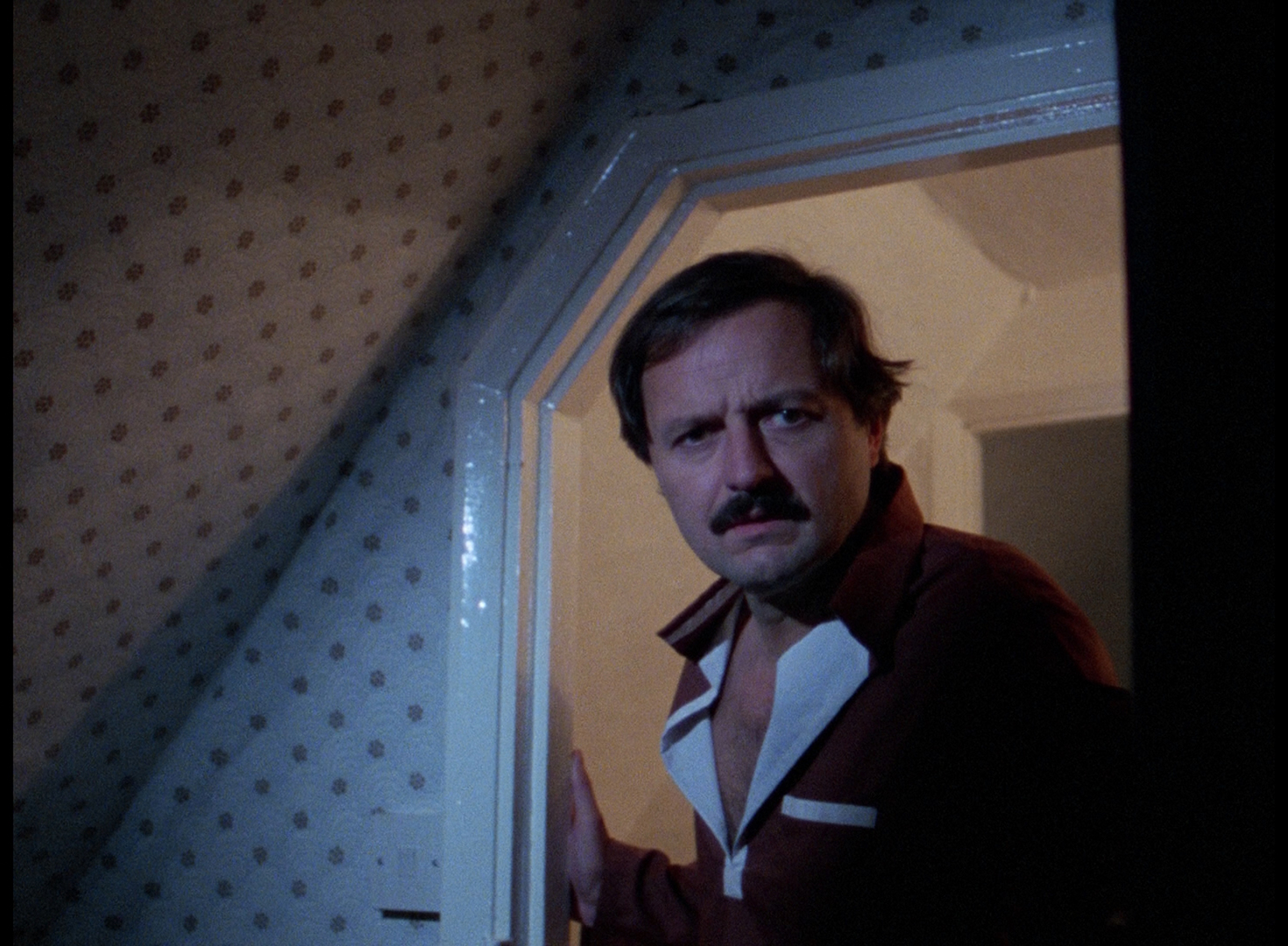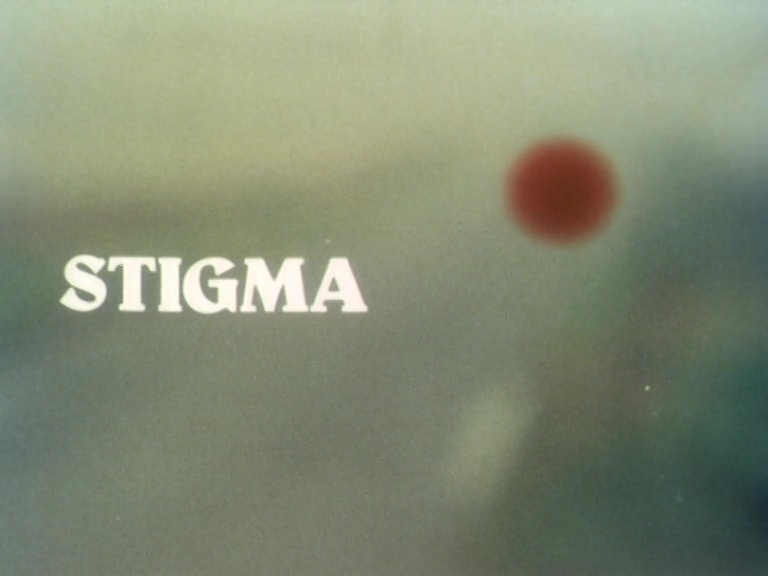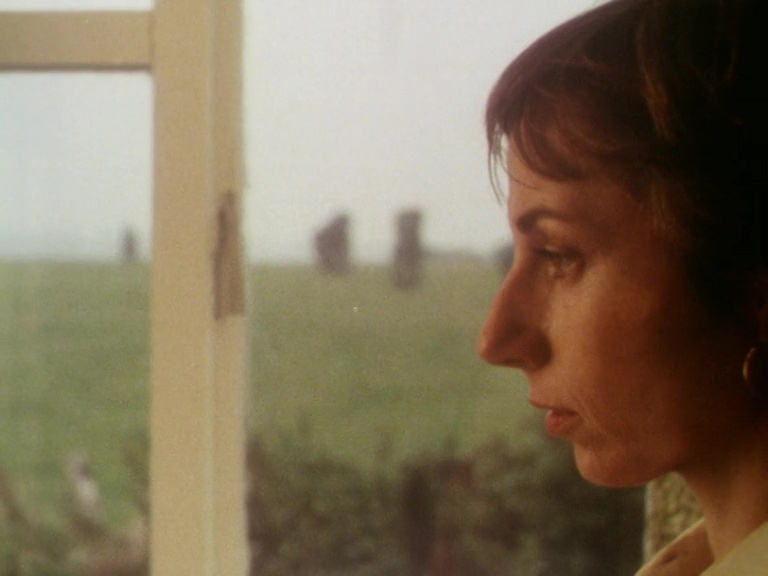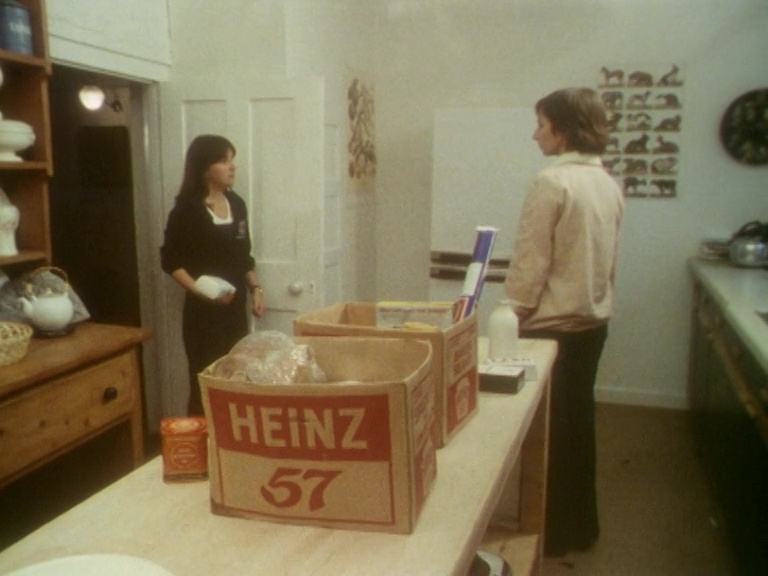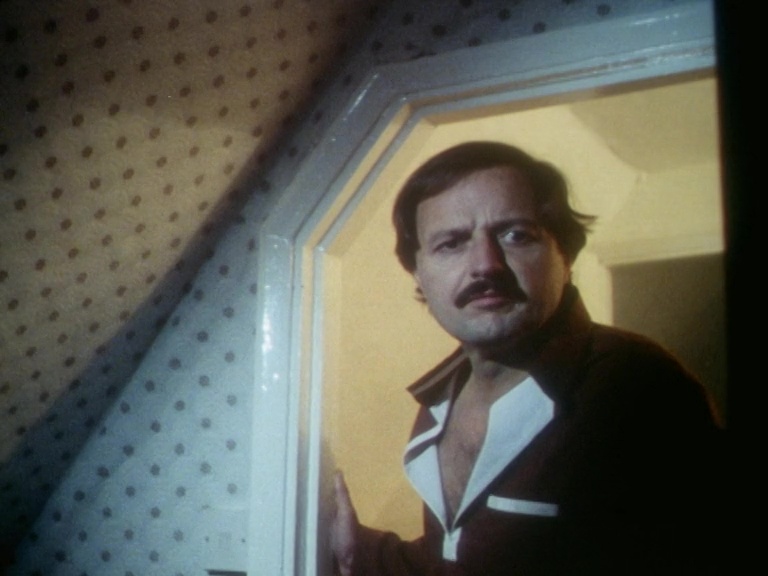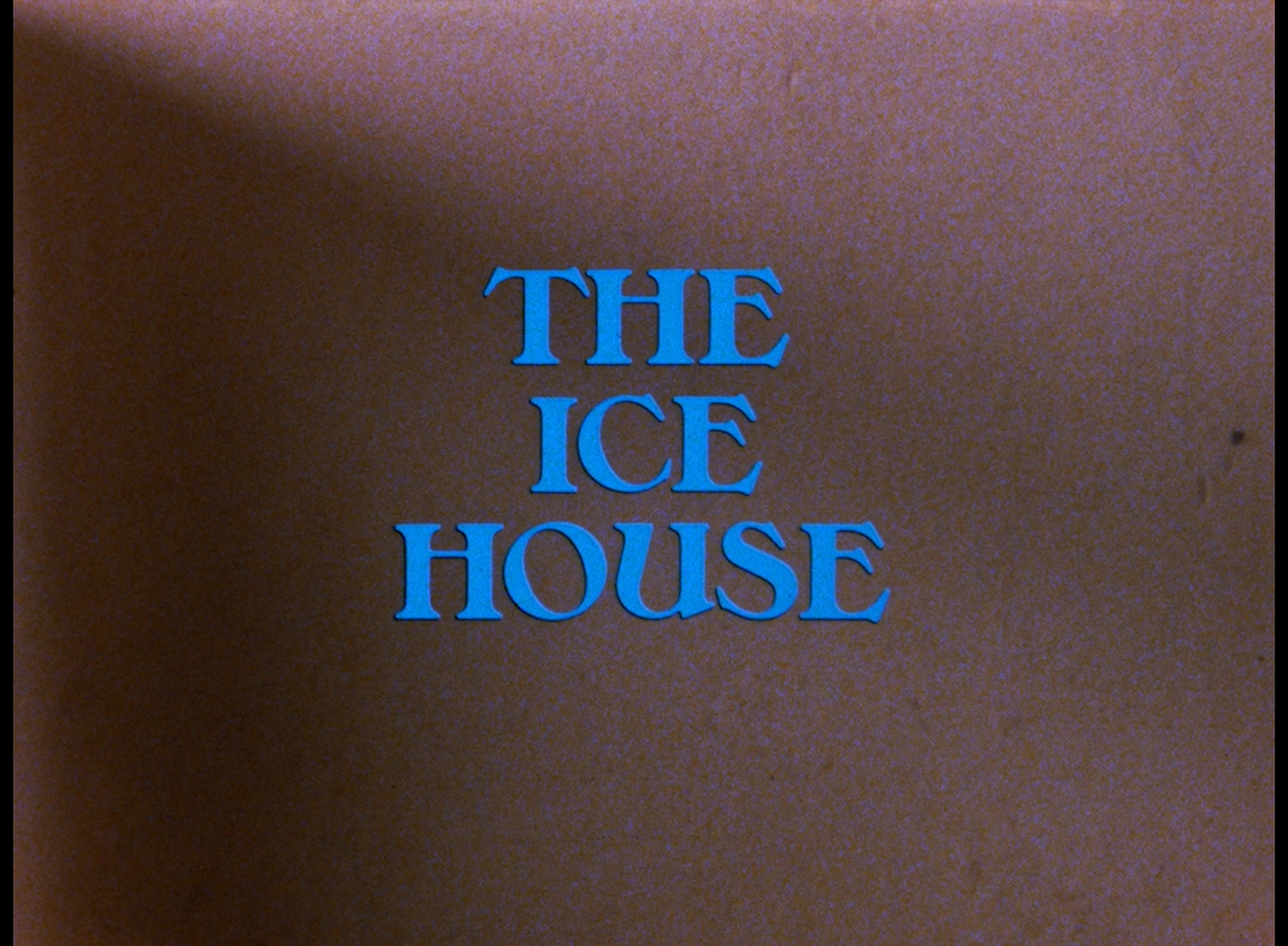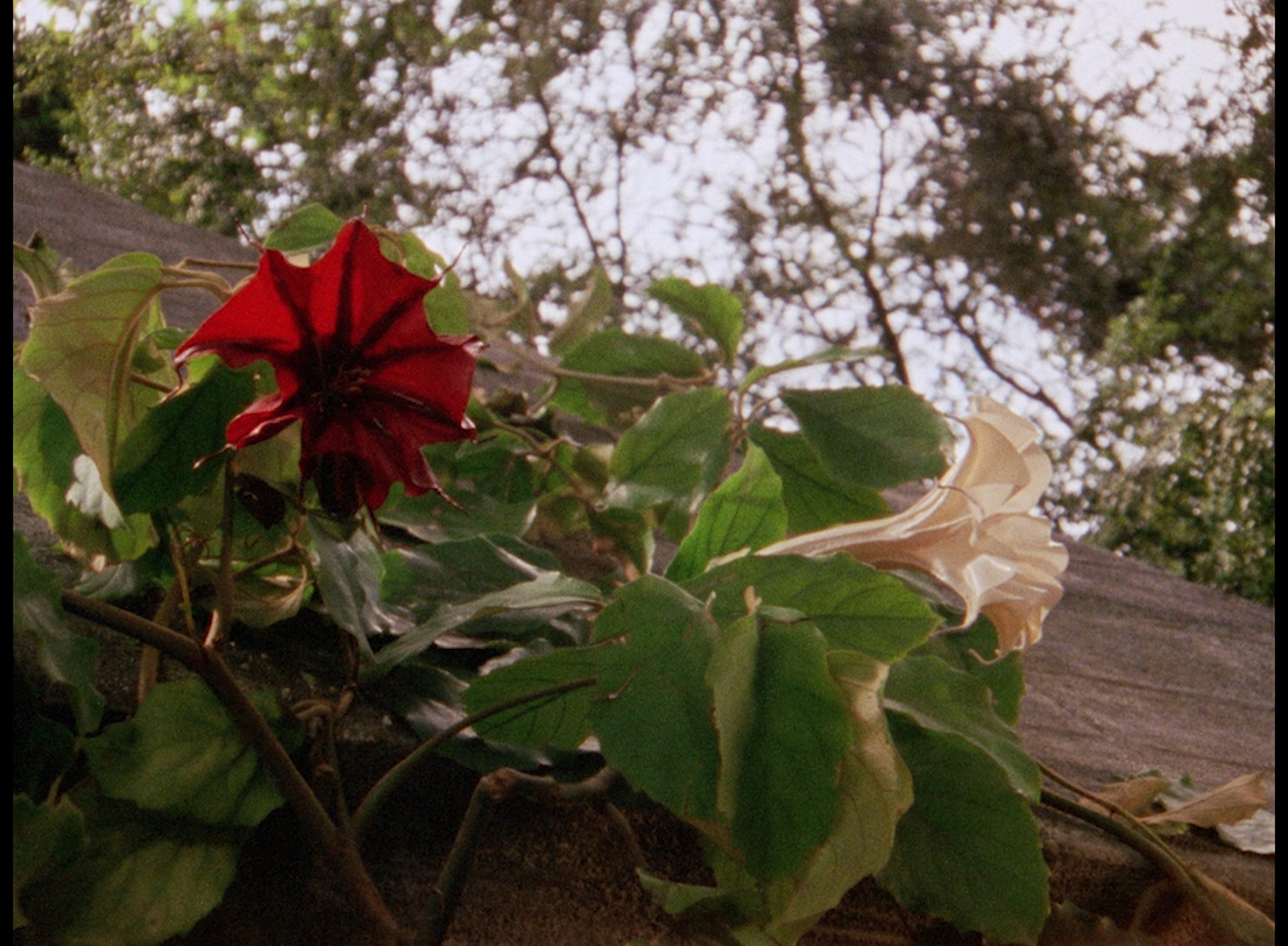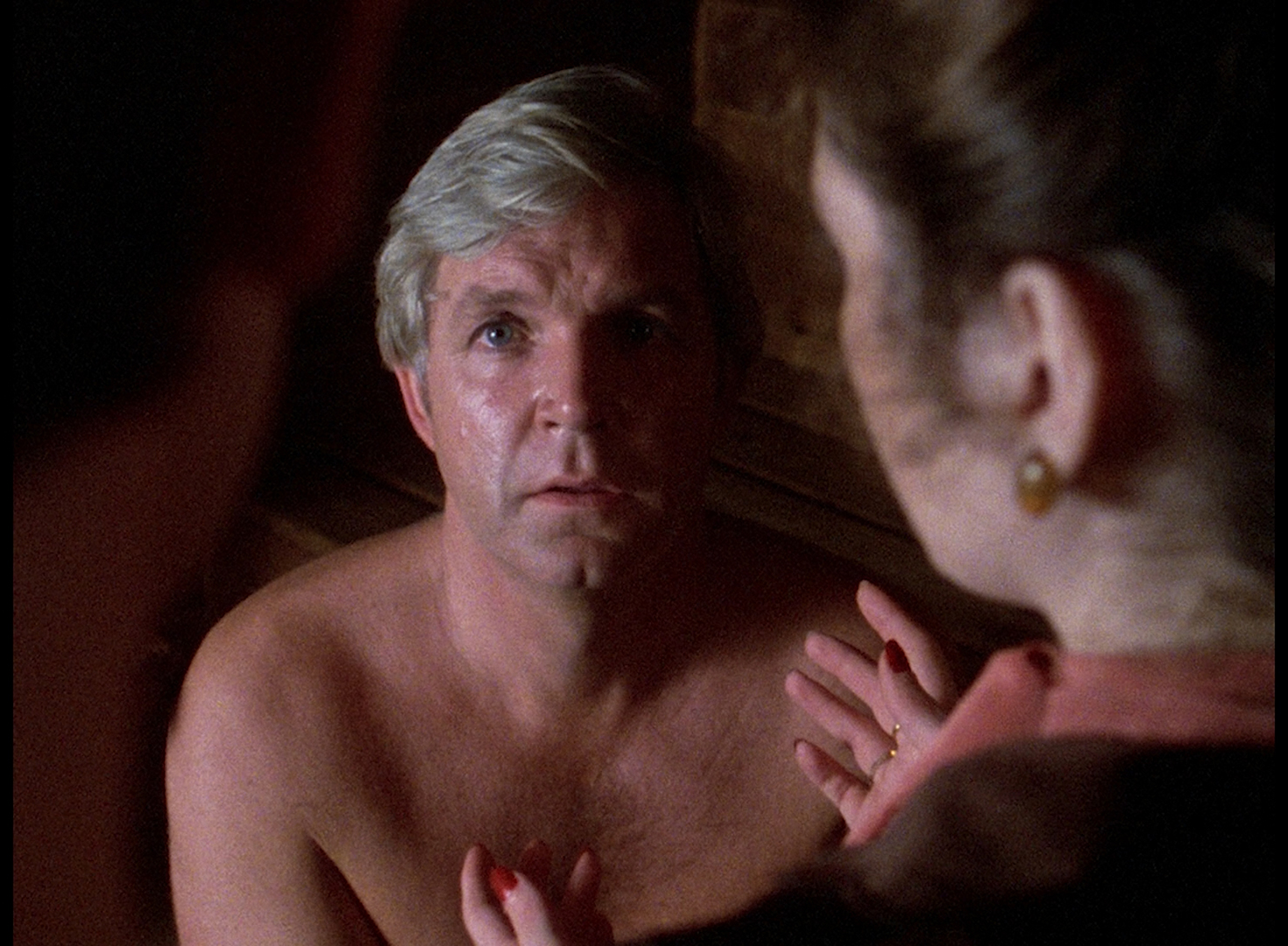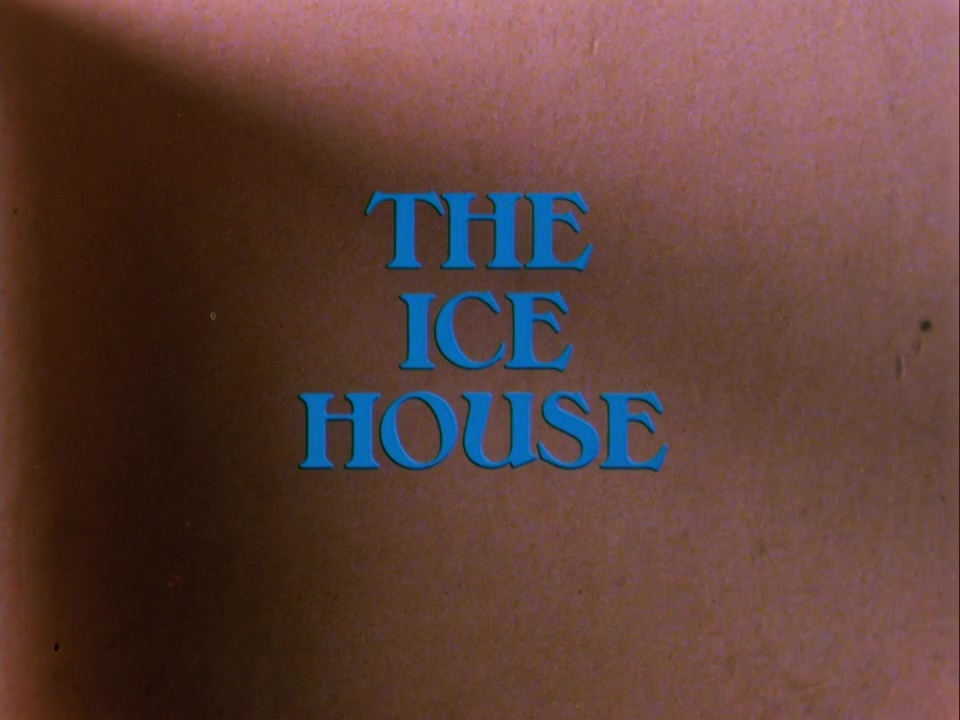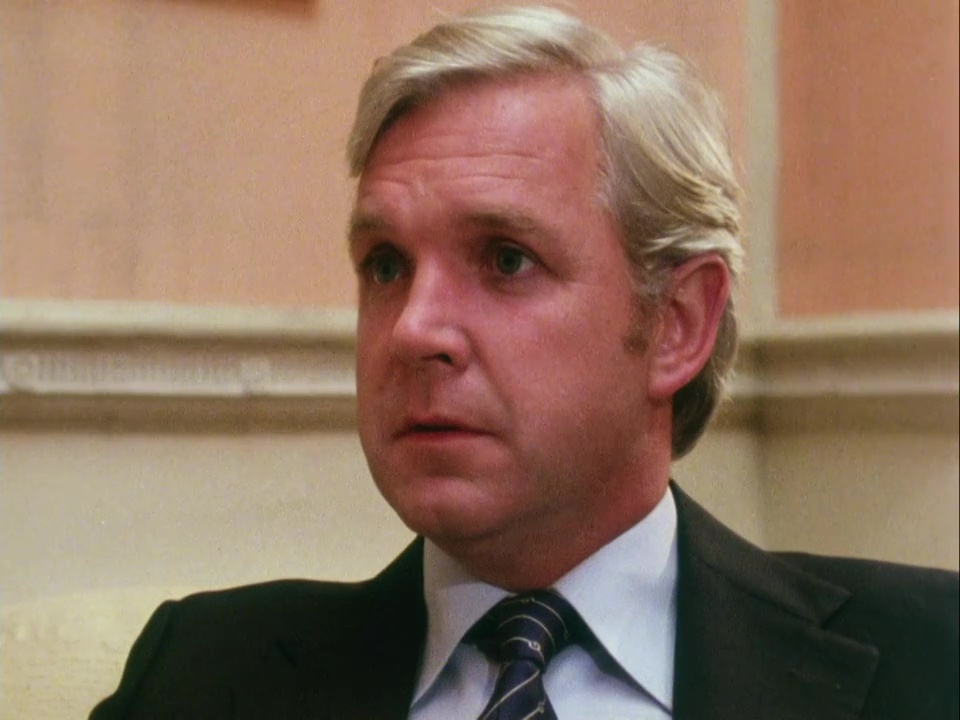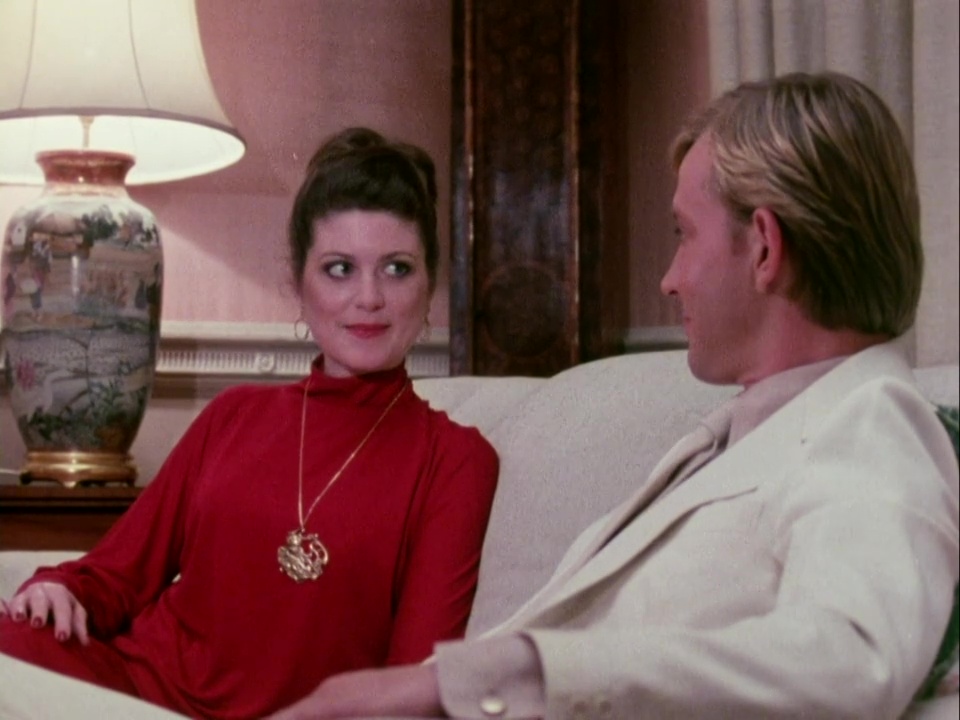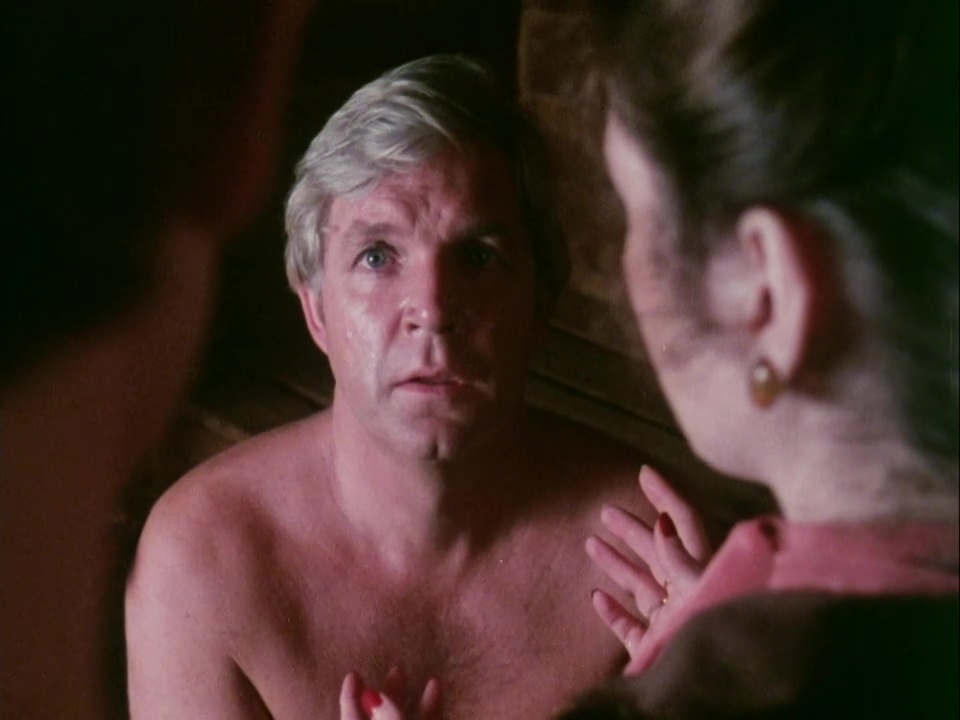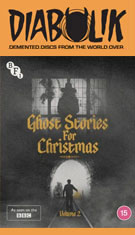
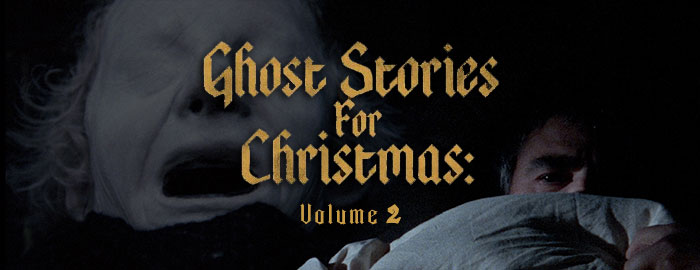
THE TREASURE OF ABBOT THOMAS
Color, 1974, 36 mins. 50 secs.
Directed by Lawrence Gordon Clark
Starring Michael Bryant, Paul Lavers, Sheila Dunn, Anne Blake, Frank Mills
THE ASH TREE
Color, 1975, 31 mins. 50 secs.
Directed by Lawrence Gordon Clark
Starring Edward Petherbridge, Preston Lockwood, Barbara Ewing, Lalla Ward
THE SIGNALMAN
Color, 1976, 38 mins. 11 secs.
Directed by Lawrence Gordon Clark
Starring Denholm Elliott, Bernard Lloyd
STIGMA
Color, 1977, 31 mins. 47 secs.
Directed by Lawrence Gordon Clark
Starring Kate Binchy, Peter Bowles, Maxine Gordon
THE ICE HOUSE
Color, 1978, 34 mins. 12 secs.
Directed by Derek Lister
Starring John Stride, David Beames, Elizabeth Romilly, Geoffrey Burridge
A VIEW FROM A HILL
Color, 2005, 39 mins. 2 secs.
Directed by Luke Watson
Starring Mark Lethern, Pip Torrens, David Burke
NUMBER 13
Color, 2006, 40 mins. 12 secs.
Directed by Pier Wilkie
Starring Greg Wise, Paul Freeman, David Burke
BFI (Blu-ray & DVD) (UK RB/R2 PAL), Shock (DVD) (Australia R4 PAL)
A year after delivering the essential 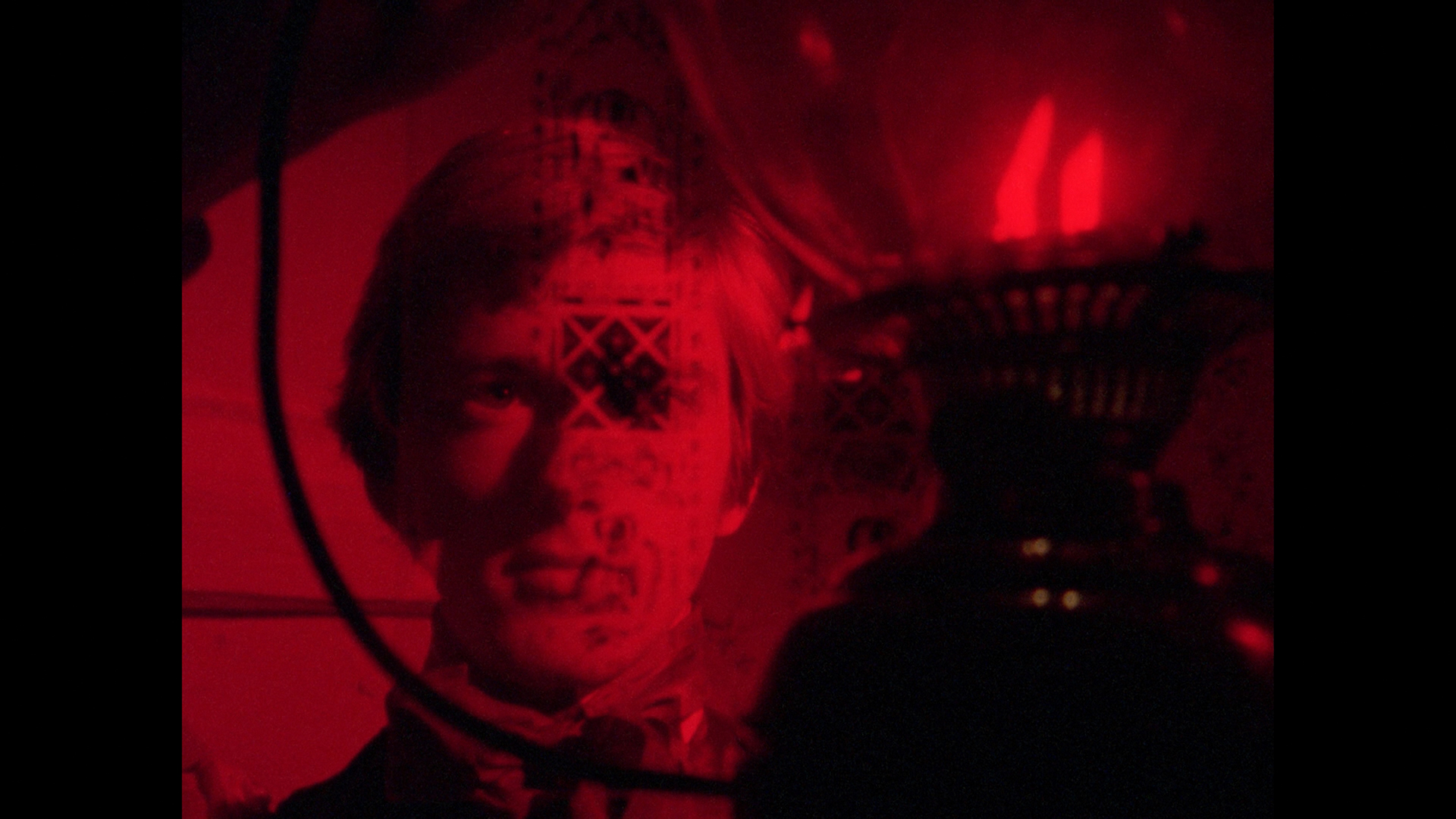 Blu-ray set, Ghost Stories for Christmas: Volume One, the BFI returned for the winter of 2023 with another
Blu-ray set, Ghost Stories for Christmas: Volume One, the BFI returned for the winter of 2023 with another  collection of the annual BBC spooky stories that defined U.K. small screen viewing in the '70s and made a welcome comeback in the current millennium. Here in Ghost Stories for Christmas: Volume Two, you get three prime era classics, a pair of unusual detours that closed out the series in its initial run, and the two episodes from the mid-'00s that kicked things back in gear again with entries now coming out in time for Christmas every year.
collection of the annual BBC spooky stories that defined U.K. small screen viewing in the '70s and made a welcome comeback in the current millennium. Here in Ghost Stories for Christmas: Volume Two, you get three prime era classics, a pair of unusual detours that closed out the series in its initial run, and the two episodes from the mid-'00s that kicked things back in gear again with entries now coming out in time for Christmas every year.
First up on disc one is The Treasure of Abbot Thomas from 1974, which feels like something of a cousin to the earlier The Stalls of Barchester as it involves a treasure hunt inside an old church (of course). Reverend Somerton (The Stone Tape's Bryant) enjoys debunking the supernatural, even when it comes to seances held by the mother of one of his friends, Lord Peter (TV presenter Lavers, a dead ringer for Shane Briant). Adamant but not all that convincing that he has no monetary interest, the Reverend would much rather spend his time hunting for the legendary treasure of mysterious alchemist Abbot Thomas, which has been hidden somewhere on the  monastery grounds on which Somerton now resides. After much deciphering of Latin and breaking of codes, Somerton,
monastery grounds on which Somerton now resides. After much deciphering of Latin and breaking of codes, Somerton,  with the aid of Lord Peter, finally finds his way to an underground catacomb where a strange black slime seems to emanate from the treasure's location. But that's just the beginning of the horrors waiting in store for him...
with the aid of Lord Peter, finally finds his way to an underground catacomb where a strange black slime seems to emanate from the treasure's location. But that's just the beginning of the horrors waiting in store for him...
Sort of a Jamesian spin on the code-breaking games of Poe's "The Gold Bug" but with a supernatural sting in its tail, this one is more of a medieval-tinged puzzle as the two men try to piece together the mystery of the missing treasure. The swerve into full-on gothic terror in the final stretch climaxes with a great shock sequence in the catacombs and an eerie little coda, coupled with a chilling choir-augmented score. Fine stuff all around, this wouldn't be the best title for newcomers to jump into first -- but it's definitely worth viewing. Never granted an official video release until its pairing on DVD from the BFI with Lost Hearts, this one has looked solid on home video and better than the dupey TV airings copied and swapped by collectors for years.
Also on the first Blu-ray is the last of director Lawrence Gordon Clark's James tales for the BBC, The Ash Tree. It's easily the most obscure up to that point as it rarely reappeared on TV, but the nightmarish finale left a major impression on some lucky viewers as it involved a rampaging horde of... well, let's just 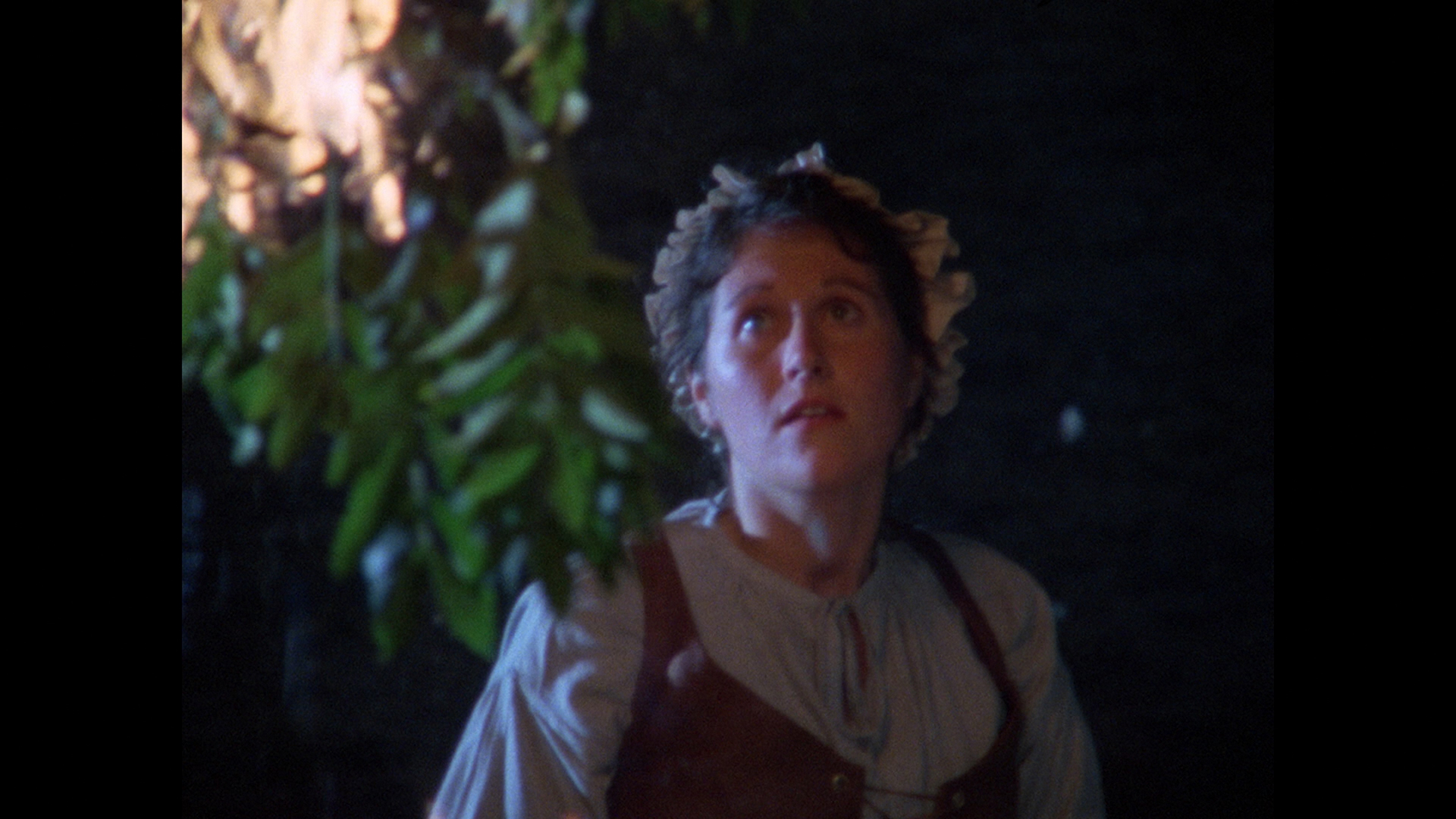 say fans of "The Zanti Misfits" from The Outer Limits will find an even more grotesque variation on that idea here.
say fans of "The Zanti Misfits" from The Outer Limits will find an even more grotesque variation on that idea here.  The always excellent Edward Petherbridge (who later went on to play Lord Peter Wimsey in a great trio of '80s UK TV mysteries) carries the show here as Sir Richard, a layabout who inherits the estate of his late uncle. Unfortunately, upon arrival he's haunted by dreams of his witch-hunting ancestor, Sir Matthew (Petherbridge again), whose bloodline was cursed by a hanged sorceress. Soon animals start dropping dead on the property, and the huge, seemingly impenetrable ash tree outside his window seems to play a larger role in the supernatural history of the house than anyone's letting on. This one's really all about the final five minutes, a dark, scary, fiery finale that probably sent the majority of its viewers rushing to flip on the lights after the credits rolled. Seeing so overtly monstrous and horrific in a James adaptation is still a bit surprising, and Clark wisely keeps things dim and shadowy enough to pack a punch within the confines of that familiar film stock.
The always excellent Edward Petherbridge (who later went on to play Lord Peter Wimsey in a great trio of '80s UK TV mysteries) carries the show here as Sir Richard, a layabout who inherits the estate of his late uncle. Unfortunately, upon arrival he's haunted by dreams of his witch-hunting ancestor, Sir Matthew (Petherbridge again), whose bloodline was cursed by a hanged sorceress. Soon animals start dropping dead on the property, and the huge, seemingly impenetrable ash tree outside his window seems to play a larger role in the supernatural history of the house than anyone's letting on. This one's really all about the final five minutes, a dark, scary, fiery finale that probably sent the majority of its viewers rushing to flip on the lights after the credits rolled. Seeing so overtly monstrous and horrific in a James adaptation is still a bit surprising, and Clark wisely keeps things dim and shadowy enough to pack a punch within the confines of that familiar film stock.
The BFI DVD release (which appeared in a Halloween-timed set of five discs with the rest of the BBC ghost stories) came with individual video intros for each story, with Clark reminiscing 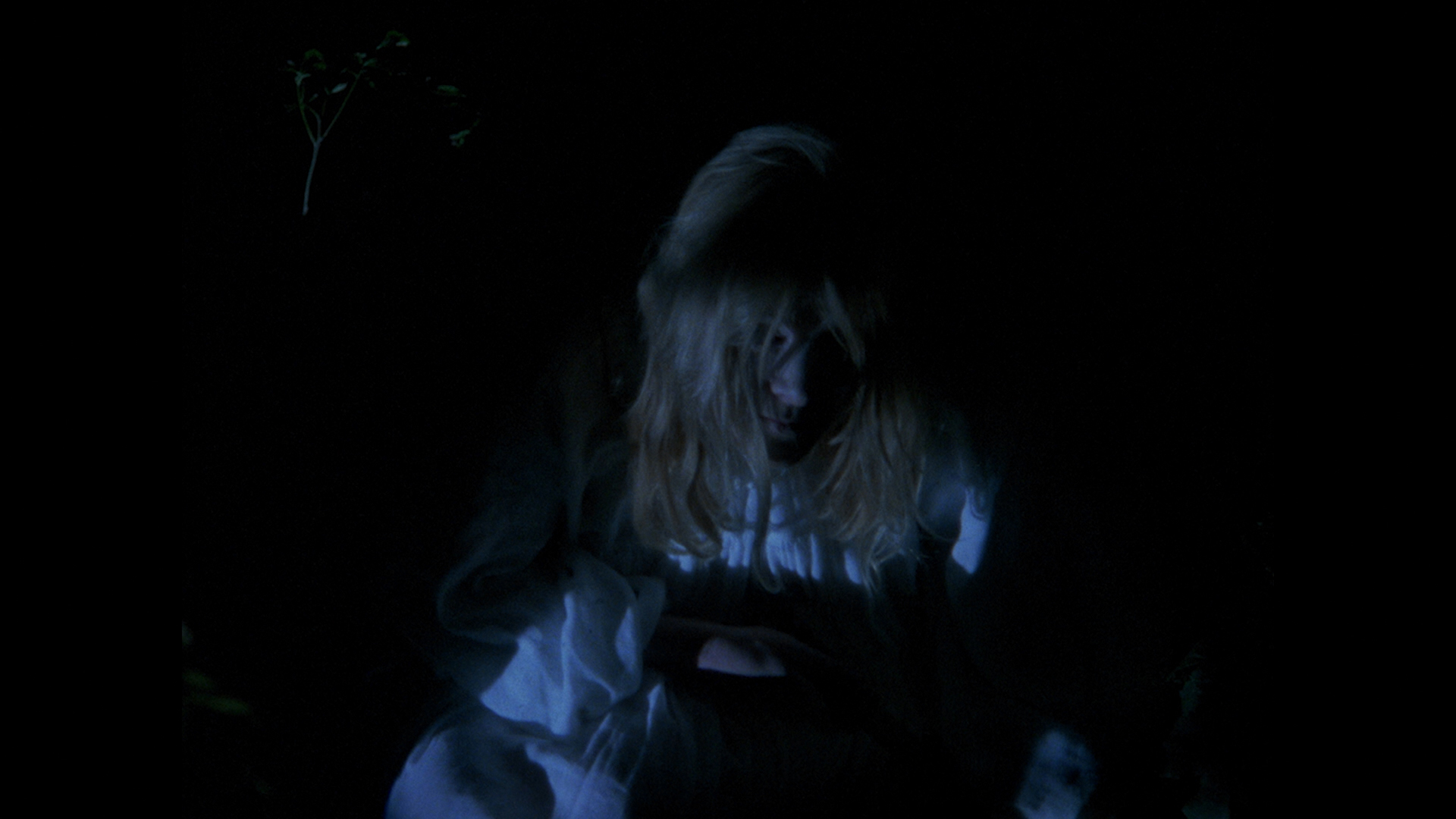 between eight to ten minutes apiece about how each short story was chosen and how he continued to maneuver around the network's perception of him as a documentarian. Some of the more important points include the switch to using a
between eight to ten minutes apiece about how each short story was chosen and how he continued to maneuver around the network's perception of him as a documentarian. Some of the more important points include the switch to using a 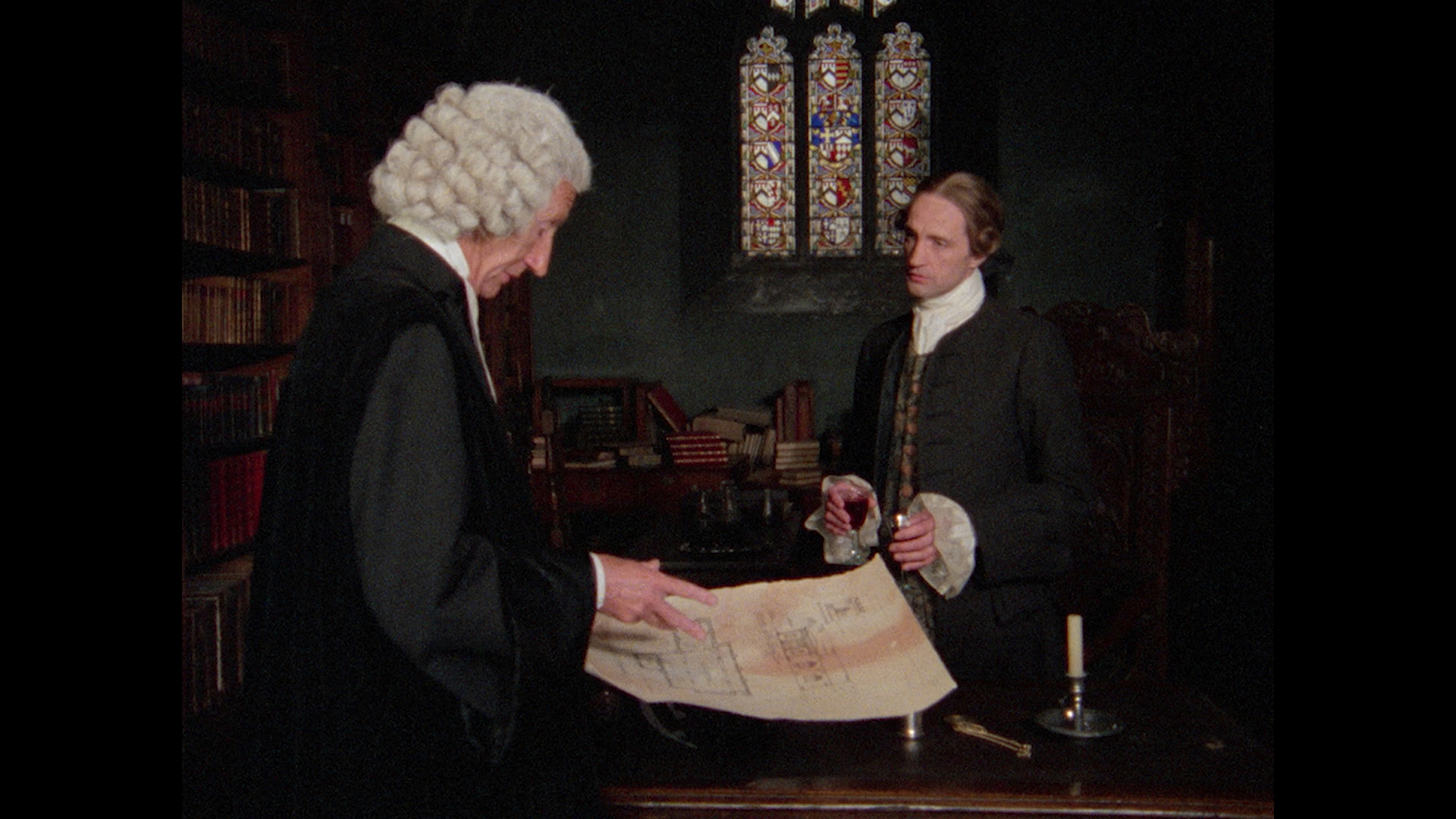 different screenwriter than himself for the first time and his insistence on using storyboards, but the best segment is easily the one for "The Ash Tree." He rattles off some great stories about how the production team couldn't find a suitable house with an ash tree in front of it (so they used reverse shots of the ash tree outside his own home thirty miles away from the main filming location) and how one of the monstrous beasties from the finale remained stuck in that tree long afterwards, much to the distress of passersby. The liner notes booklet includes an essay by the great Ramsey Campbell for "Lost Hearts" (in which he points out a few salient observations about changes to the story and the evocative use of fog), an Alex Davidson essay for "The Treasure of Abbott Thomas" (who considers several of the changes to the original text to be improvements), and Dick Fiddy's take on "The Ash Tree" (focusing on the script by playwright David Rudkin and the palpable sense of doom created by the performances). On top of that you get bios for James and Clark, an additional recap essay on all three by actor/writer Robert Lloyd Parry focusing strictly on their literary angle, and even a sample Abbott Thomas storyboard. Truly spooky, truly
different screenwriter than himself for the first time and his insistence on using storyboards, but the best segment is easily the one for "The Ash Tree." He rattles off some great stories about how the production team couldn't find a suitable house with an ash tree in front of it (so they used reverse shots of the ash tree outside his own home thirty miles away from the main filming location) and how one of the monstrous beasties from the finale remained stuck in that tree long afterwards, much to the distress of passersby. The liner notes booklet includes an essay by the great Ramsey Campbell for "Lost Hearts" (in which he points out a few salient observations about changes to the story and the evocative use of fog), an Alex Davidson essay for "The Treasure of Abbott Thomas" (who considers several of the changes to the original text to be improvements), and Dick Fiddy's take on "The Ash Tree" (focusing on the script by playwright David Rudkin and the palpable sense of doom created by the performances). On top of that you get bios for James and Clark, an additional recap essay on all three by actor/writer Robert Lloyd Parry focusing strictly on their literary angle, and even a sample Abbott Thomas storyboard. Truly spooky, truly 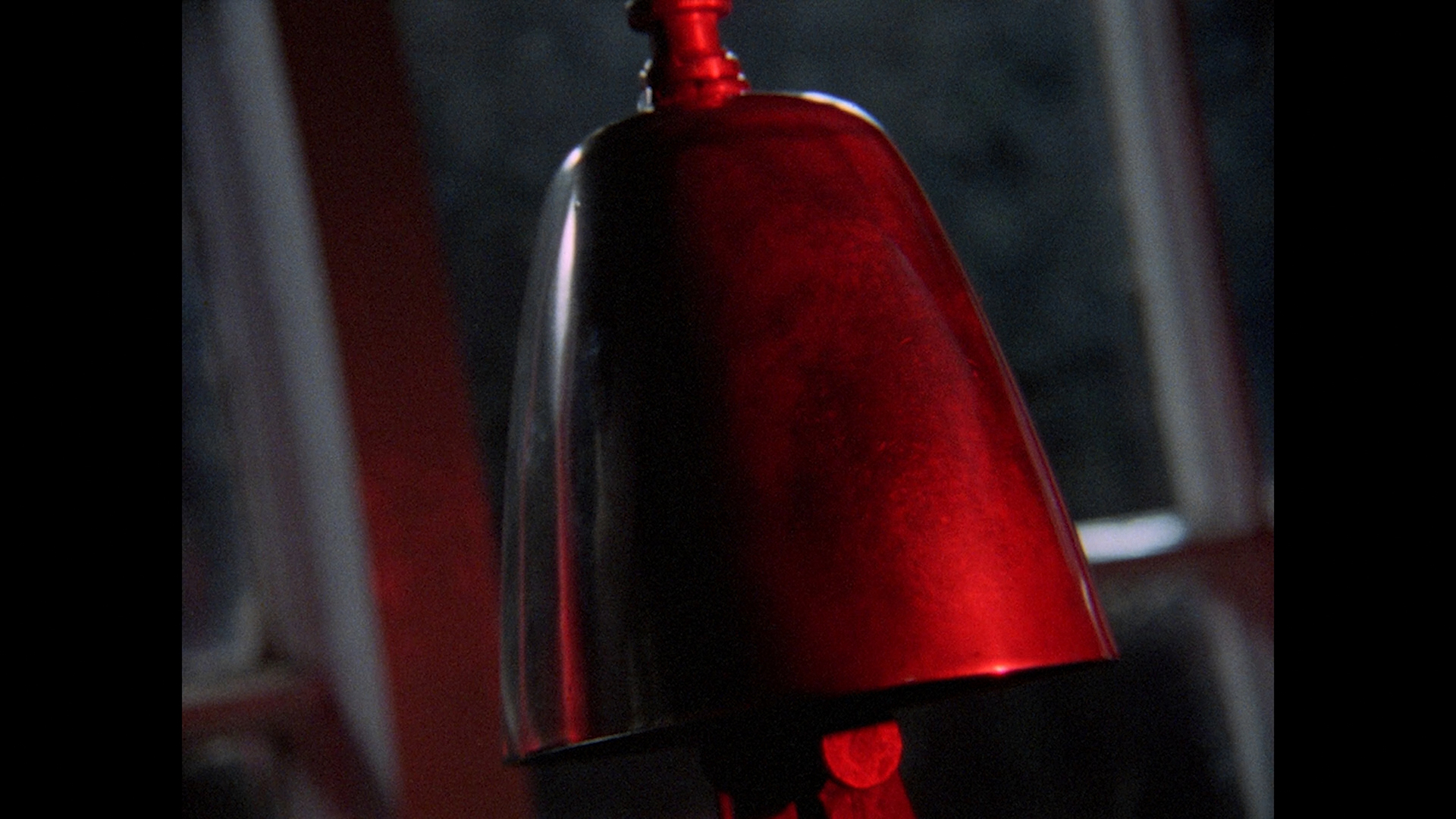 wonderful.
wonderful.
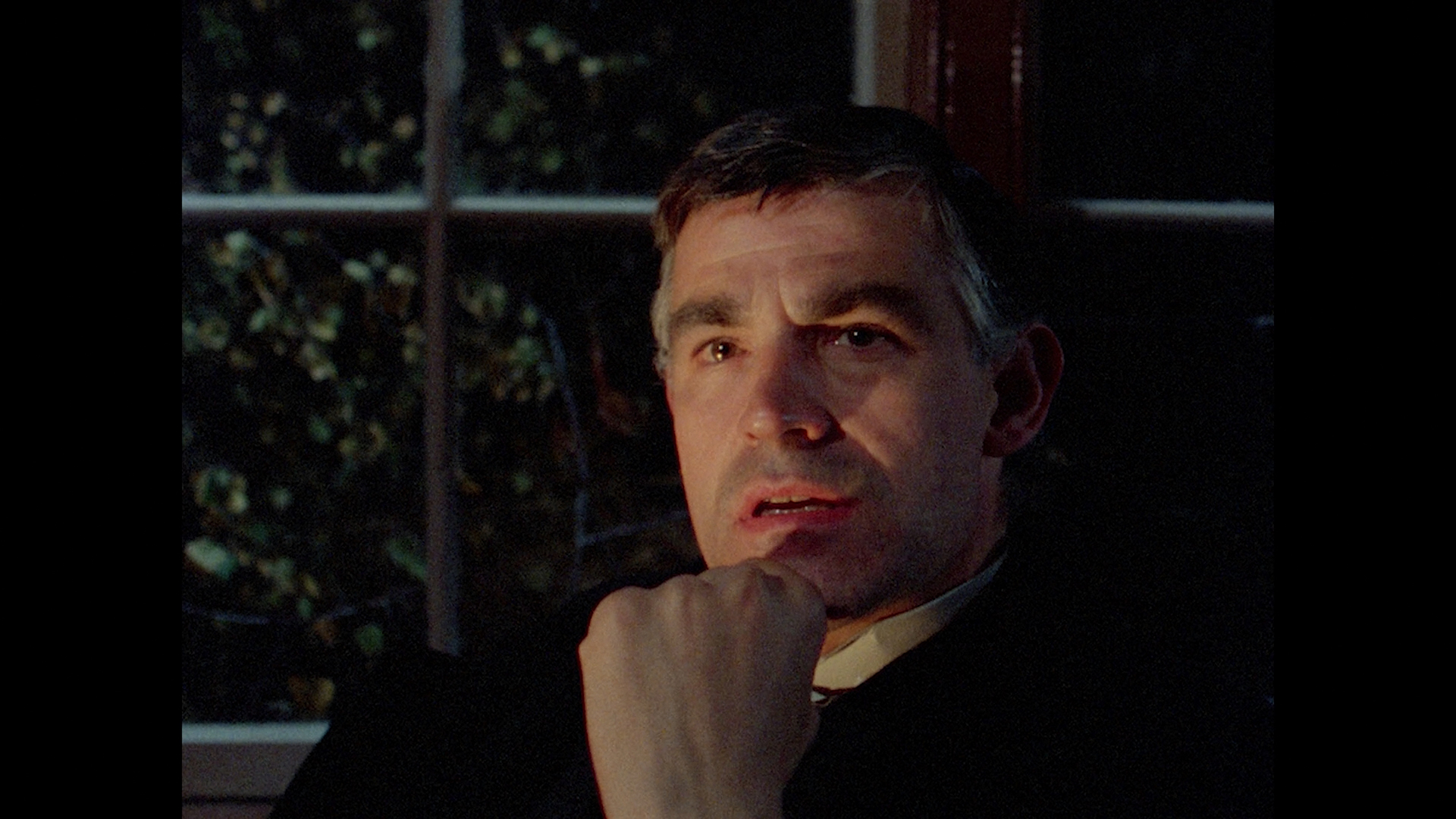 By the mid-1970s, the annual TV ritual was bound to change after a succession of M.R. James adaptations. The 1976 entry was originally planned as James' "Count Magnus" (eventually filmed in 2022), but budgetary costs sent them searching for a new short story to adapt. The choice was made to tackle Charles Dickens' classic tale The Signalman, a short and chilling two-character piece that could easily be filmed in the English countryside with a minimum of actors. Fortunately the result, which kicks off the second Blu-ray, turned out to be one of the best in the series (in fact, it's a favorite of many), thanks in no small part to its sterling performance by Denholm Elliott and an underrated but effective one by TV actor Bernard Lloyd. It also didn't hurt that this was one of the earlier writing credits for Andrew Davies, who went on to write the terrific (and maddeningly still unavailable) BBC thriller Mother Love and the definitive version of Pride and Prejudice. (He also wrote the Bridget Jones movies, but everyone has to pay the rent.)
By the mid-1970s, the annual TV ritual was bound to change after a succession of M.R. James adaptations. The 1976 entry was originally planned as James' "Count Magnus" (eventually filmed in 2022), but budgetary costs sent them searching for a new short story to adapt. The choice was made to tackle Charles Dickens' classic tale The Signalman, a short and chilling two-character piece that could easily be filmed in the English countryside with a minimum of actors. Fortunately the result, which kicks off the second Blu-ray, turned out to be one of the best in the series (in fact, it's a favorite of many), thanks in no small part to its sterling performance by Denholm Elliott and an underrated but effective one by TV actor Bernard Lloyd. It also didn't hurt that this was one of the earlier writing credits for Andrew Davies, who went on to write the terrific (and maddeningly still unavailable) BBC thriller Mother Love and the definitive version of Pride and Prejudice. (He also wrote the Bridget Jones movies, but everyone has to pay the rent.)
Inexplicably drawn during a country walk to a remote railway tunnel, a traveler (Lloyd) accidentally frightens the local signalman (Elliott) who mistakes him for... something else. They spend the following hours into darkness and another visit talking about the loneliness of living so far from modern civilization, with the signalman living a life of long stretches of boredom (studying mathematics with nothing better to do) but tasked with the great responsibility 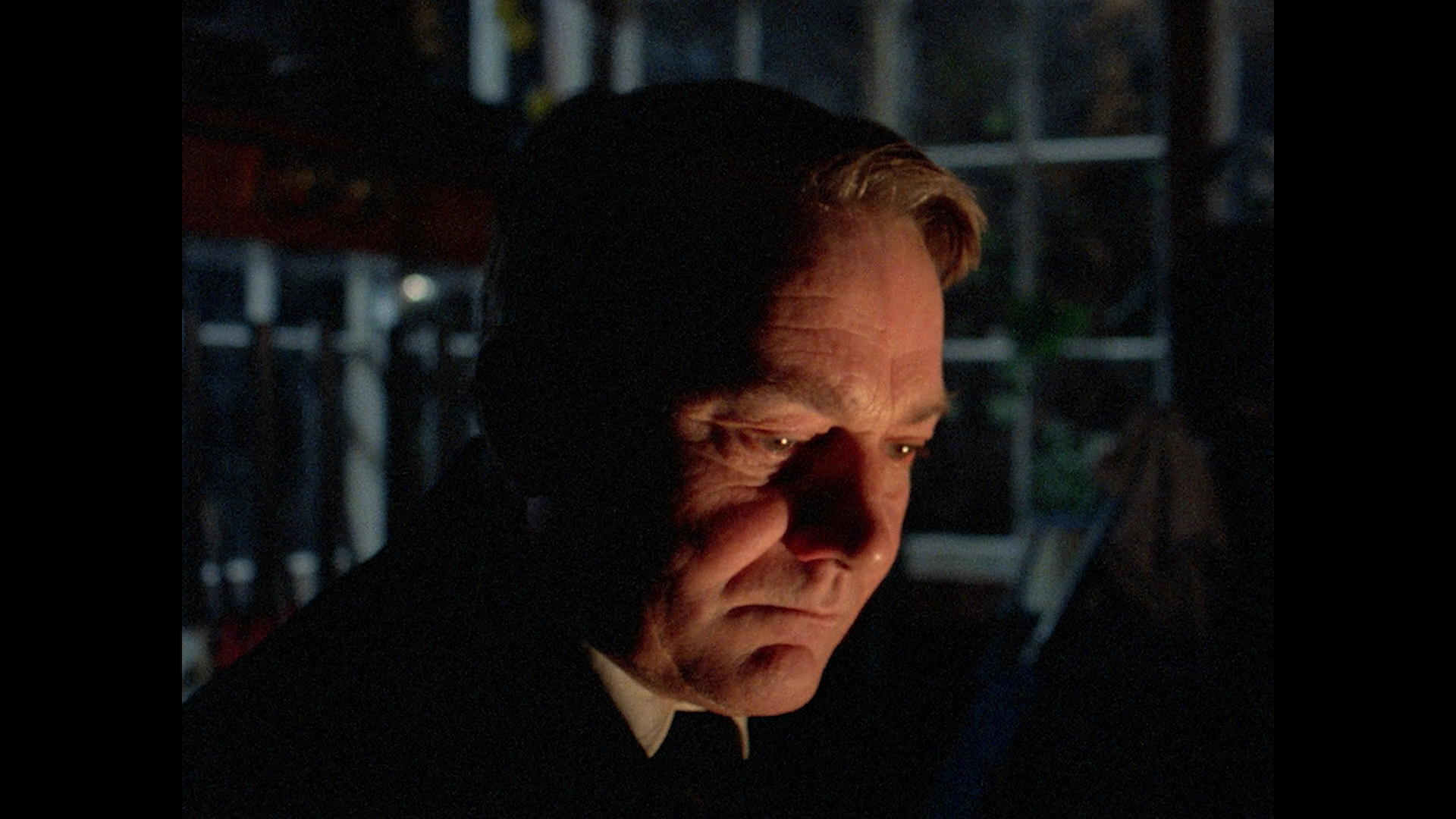 of ensuring the safe passage of
of ensuring the safe passage of 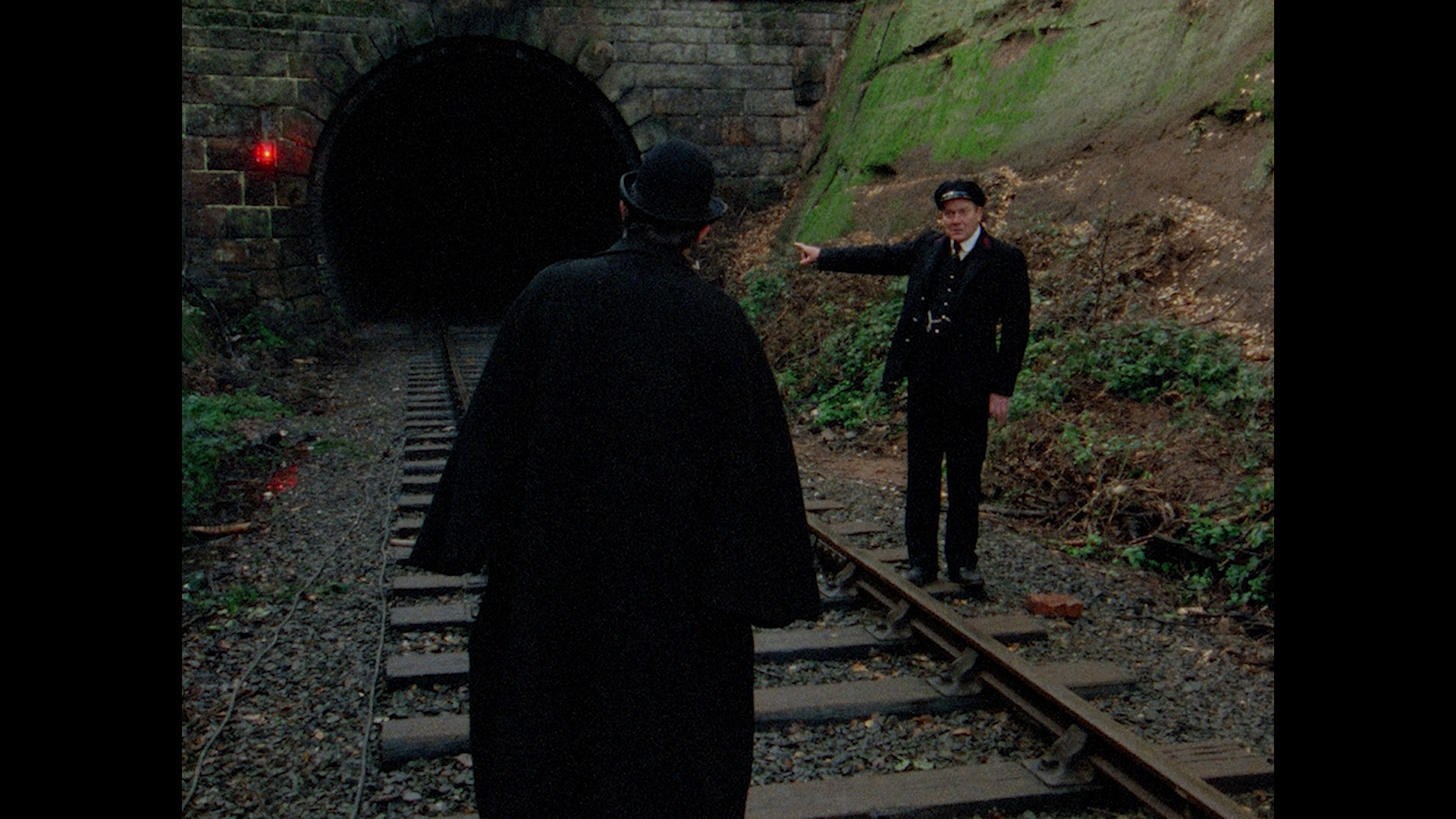 trains, particularly through the long tunnel. However, the signalman has experienced persistent visions of a shadowy man calling out and holding his arm over his face. Twice before his visions have been followed by terrible accidents, such as a terrified bride being hurled off the passing train. Now his visions have returned with full force, and he fears something dreadful is imminent.
trains, particularly through the long tunnel. However, the signalman has experienced persistent visions of a shadowy man calling out and holding his arm over his face. Twice before his visions have been followed by terrible accidents, such as a terrified bride being hurled off the passing train. Now his visions have returned with full force, and he fears something dreadful is imminent.
A magnificent exercise in isolated atmosphere and mounting unease, The Signalman marked the last period outing in the '70s for the BBC ghost stories but really closed it out with a bang. The actual scares are ladled out sparingly (the apparition's face is definitely chilling stuff!), with much of the emphasis instead placed on the melancholy existence of a man who must work and live alone to serve the progress of a world he can't even see. It's a haunting tale in every sense, and as far as literary adaptations go, it's hard to imagine one much more potent than this. The BFI originally released this film as a standalone DVD back in 2002, basically bare bones apart from a little text extra and some liner notes. The transfer was adequate for the time but definitely on the soft side, even looking borderline blurry at times. A completely different master from the BBC's American branch was issued with zero fanfare as an extra on the U.S. release of Hard Times, and that second master was used for the 2012 BFI reissue, which is more crisp and film-like with  very satisfying detail levels.
very satisfying detail levels.
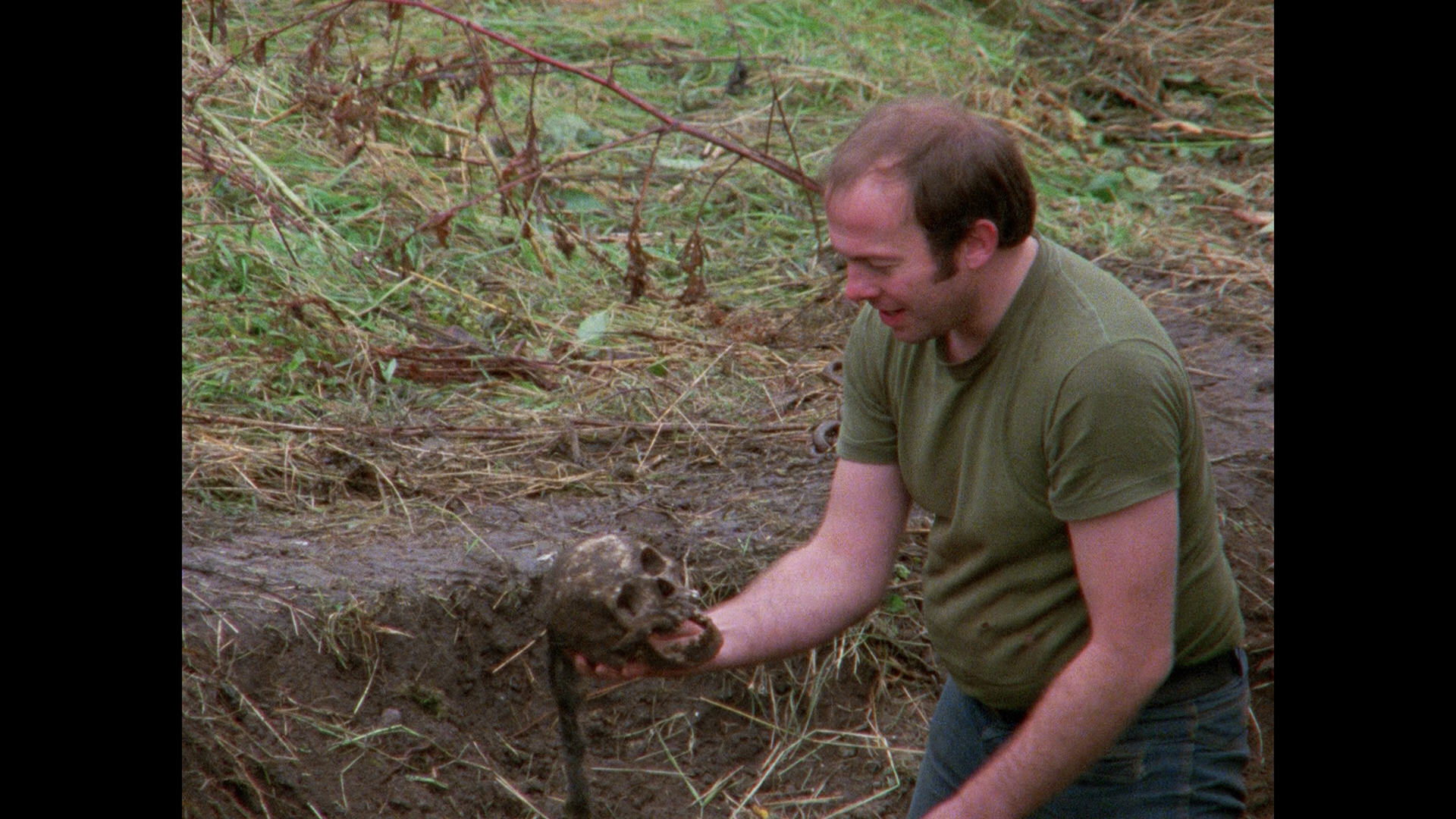 In a move that proved to be less than wise, the decision was made the following year to switch things to the present day and go with an original script not based on a short story. The result was Stigma by TV writer Clive Exton, a surprisingly intense and graphic bit of business that would still never come close to airing on prime time television in America. For the first time the focus here is not on men overtaken by the supernatural but a woman, in particular her body. Kate Binchy (who would next appear in the marvelous "Quiet as a Nun" installment of Armchair Thriller) stars as Katherine, who moves to a country home along with her husband, Paul (Bowles), and daughter Verity (Gordon). Some workmen are instructed to remove a large ancient stone in front of the house, part of a rock formation linked to a primitive sacrificial rite. As soon as the stone dislodges from the earth, a strong wind blasts both Katherine and Verity into near catatonia. Soon Katherine is plagued by uncanny events like blood seeping from her skin, fissures appearing in the walls and mirrors, and something rustling downstairs at night.
In a move that proved to be less than wise, the decision was made the following year to switch things to the present day and go with an original script not based on a short story. The result was Stigma by TV writer Clive Exton, a surprisingly intense and graphic bit of business that would still never come close to airing on prime time television in America. For the first time the focus here is not on men overtaken by the supernatural but a woman, in particular her body. Kate Binchy (who would next appear in the marvelous "Quiet as a Nun" installment of Armchair Thriller) stars as Katherine, who moves to a country home along with her husband, Paul (Bowles), and daughter Verity (Gordon). Some workmen are instructed to remove a large ancient stone in front of the house, part of a rock formation linked to a primitive sacrificial rite. As soon as the stone dislodges from the earth, a strong wind blasts both Katherine and Verity into near catatonia. Soon Katherine is plagued by uncanny events like blood seeping from her skin, fissures appearing in the walls and mirrors, and something rustling downstairs at night.
Probably a big shock indeed to families expecting another creepy but relatively bloodless bit of ghostly entertainment, Stigma pelts the viewer  with enough prolonged
with enough prolonged 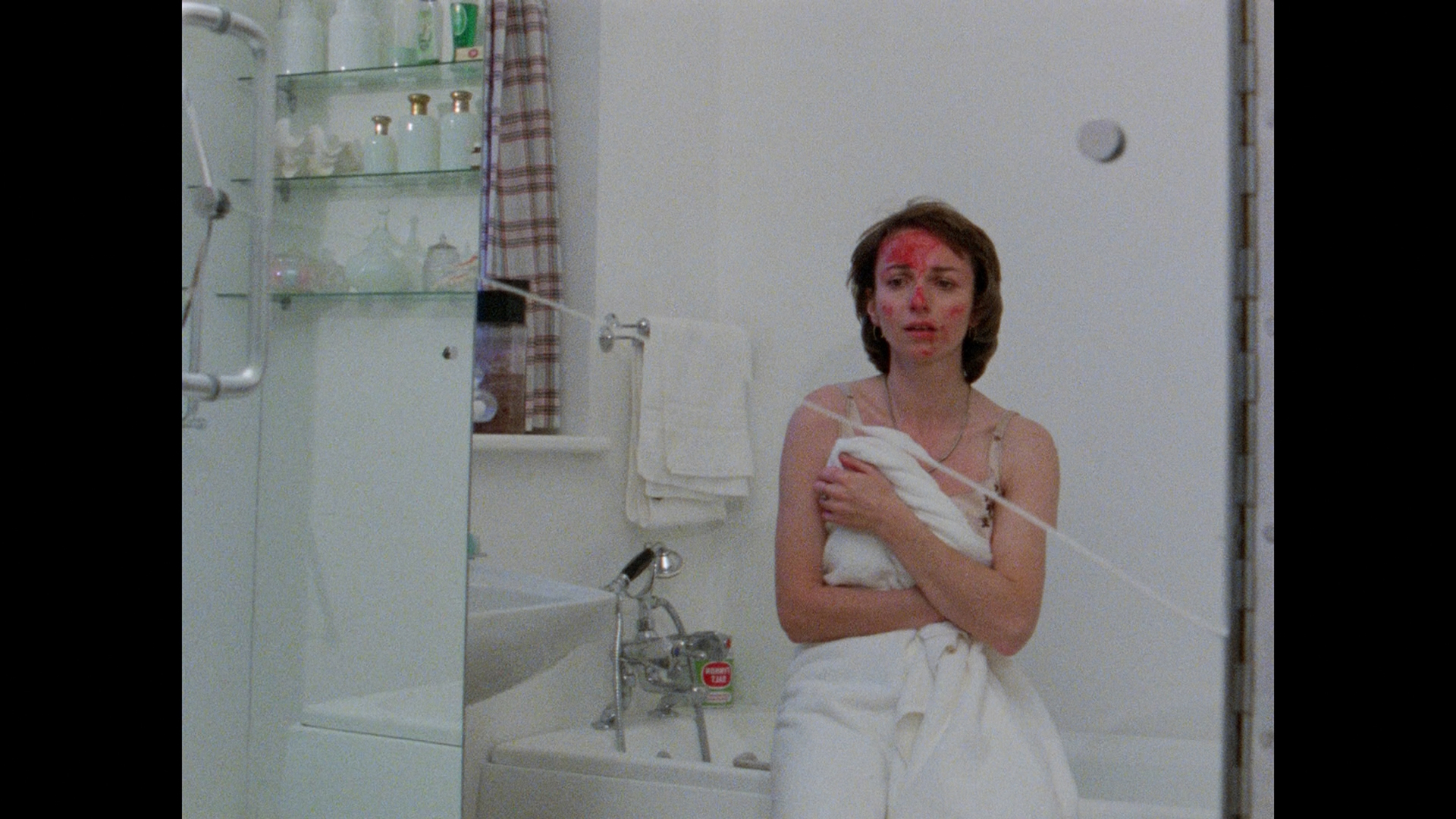 nudity and bloodshed to make one wonder whether they've accidentally stumbled into an episode of Hammer House of Horror instead. It's a harsh and downbeat piece of modern horror, one that will definitely entertain fans of the decade's move to more explicit terrors while probably blowing the minds of anyone unaware of what lies in store for them. The departure from the usual format took its toll, as this was apparently yanked from future broadcasts and became something of a black sheep among the series. It's quite a worthy addition on its own terms, though, particularly thanks to its decidedly feminine look at Cronenbergian body horror and all that entails. Women's lit students could have a field day with the symbolism in this one. For its worldwide home video debut, the BFI presented it on very solid ground in 2012 on DVD with a pretty good presentation from the only broadcast master around.
nudity and bloodshed to make one wonder whether they've accidentally stumbled into an episode of Hammer House of Horror instead. It's a harsh and downbeat piece of modern horror, one that will definitely entertain fans of the decade's move to more explicit terrors while probably blowing the minds of anyone unaware of what lies in store for them. The departure from the usual format took its toll, as this was apparently yanked from future broadcasts and became something of a black sheep among the series. It's quite a worthy addition on its own terms, though, particularly thanks to its decidedly feminine look at Cronenbergian body horror and all that entails. Women's lit students could have a field day with the symbolism in this one. For its worldwide home video debut, the BFI presented it on very solid ground in 2012 on DVD with a pretty good presentation from the only broadcast master around.
For the last of the '70s ghost stories, director Lawrence Gordon Clark left the BBC, instead going on to direct a loose but fascinating 1979 version of M.R. James' "Casting the Runes" for ITV Playhouse. Instead, Coronation Street veteran Derek Lister took the reins for another original story, The Ice House, written by John Bowen (who wrote Abbot Thomas). 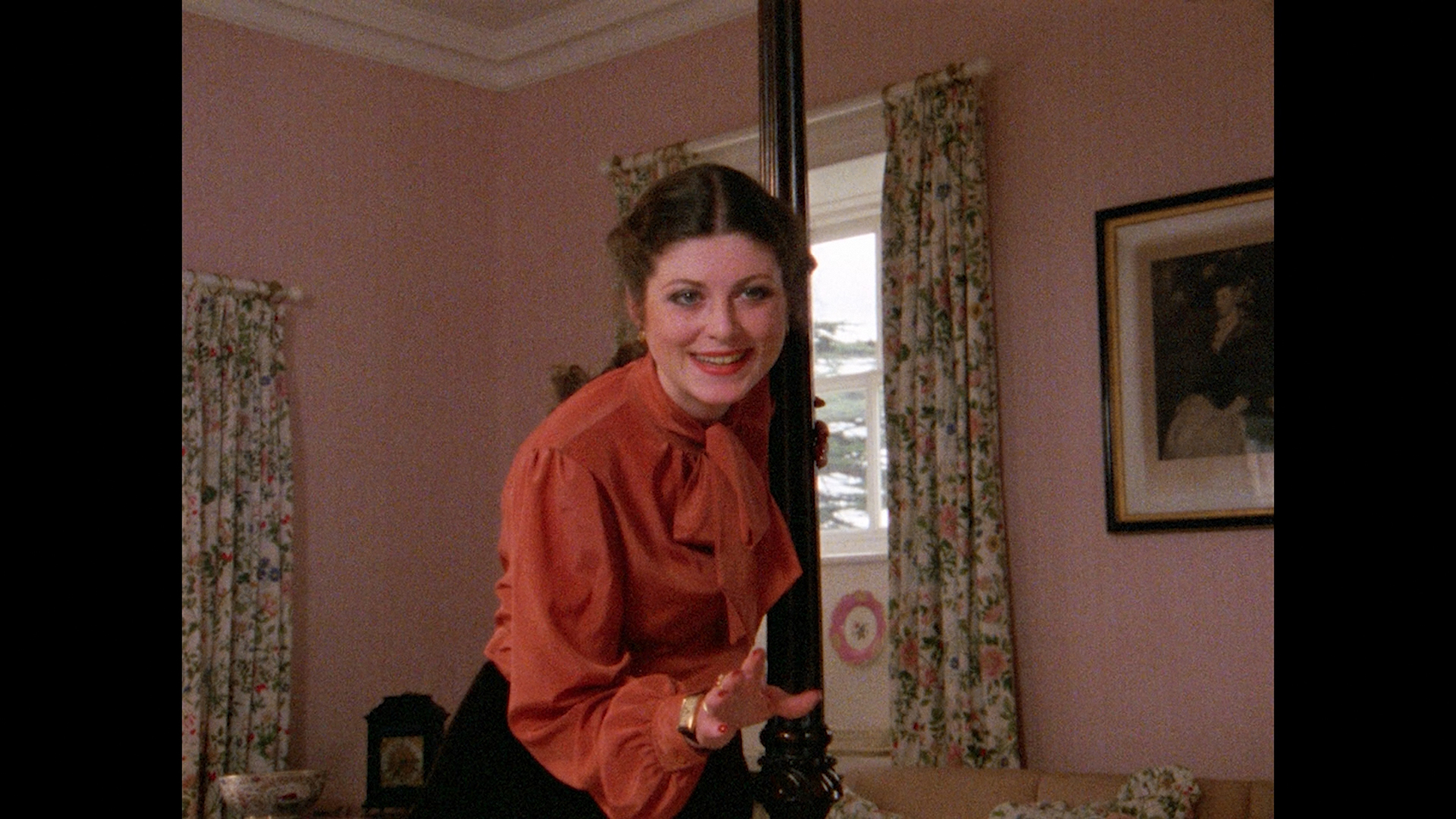 The result, which is set by itself on the third Blu-ray as the main attraction, is easily the most peculiar of the ghost story cycle, so oblique that it doesn't quite assert
The result, which is set by itself on the third Blu-ray as the main attraction, is easily the most peculiar of the ghost story cycle, so oblique that it doesn't quite assert 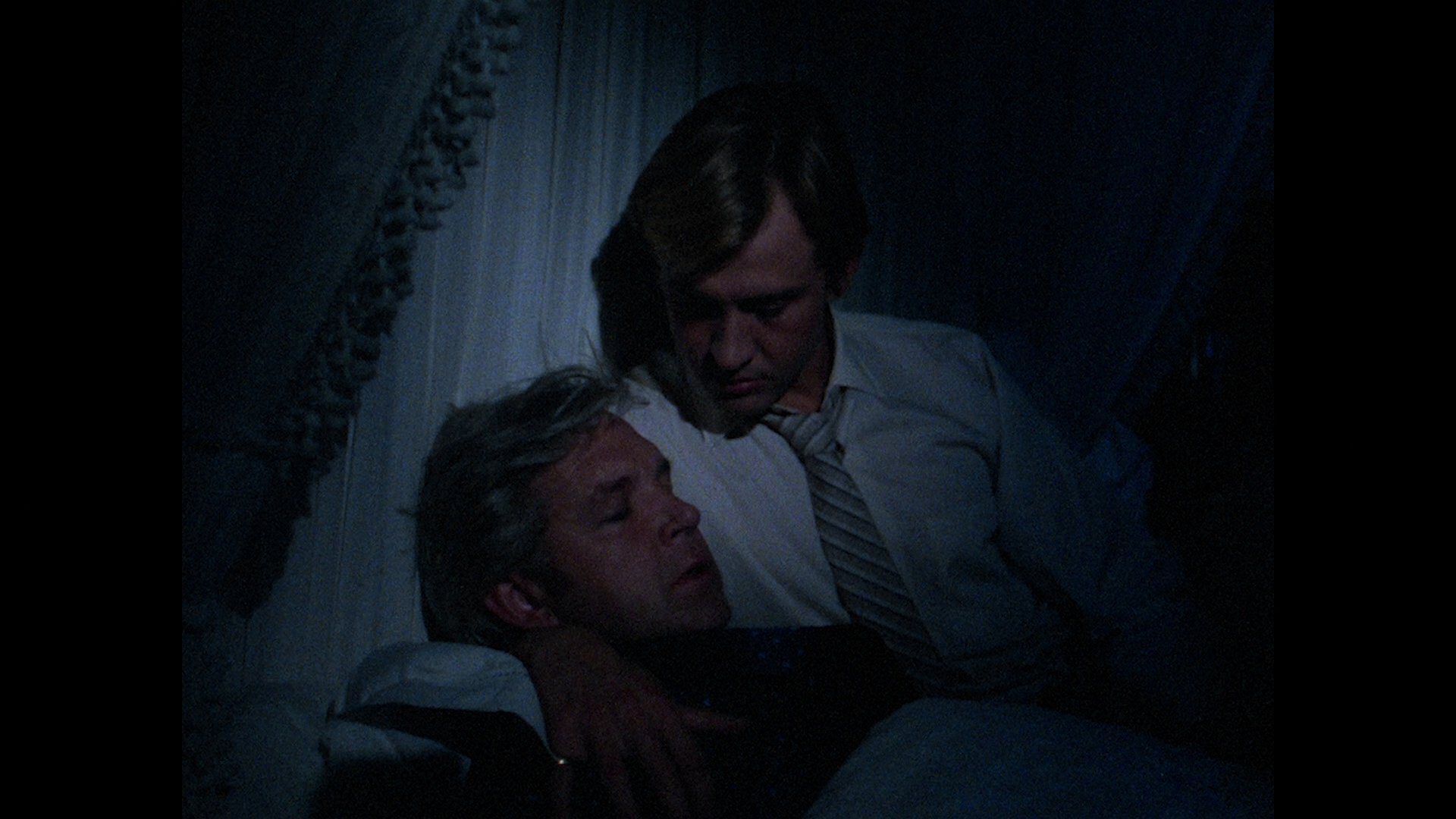 itself as a ghost story at all. The story begins with recently divorced, middle-aged Paul (The Omen's Stride) relaxing in a sauna at a country spa run by strange siblings Clovis (Burridge) and Jessica (Romilly). Strange details begin to pile up: many of the male guests seem freezing to the touch; the nearby ice house is decorated with a unique vine sprouting a pair of exotic and alluringly enormous blossoms; and the two owners seem to be... a little too close for comfort. One night Paul decides to explore the inside of the ice house, and what he finds inside accelerates his spiral into a supernatural vortex.
itself as a ghost story at all. The story begins with recently divorced, middle-aged Paul (The Omen's Stride) relaxing in a sauna at a country spa run by strange siblings Clovis (Burridge) and Jessica (Romilly). Strange details begin to pile up: many of the male guests seem freezing to the touch; the nearby ice house is decorated with a unique vine sprouting a pair of exotic and alluringly enormous blossoms; and the two owners seem to be... a little too close for comfort. One night Paul decides to explore the inside of the ice house, and what he finds inside accelerates his spiral into a supernatural vortex.
That might sound like a straightforward horror story, but The Ice House is almost defiant in its efforts to sidestep viewer expectations. There isn't much of a linear storyline, with most of the film serving as a series of barely connected sequences filled with oddness and a perverse air of sensuality. There are only a couple of moments of actual horror, though the extremely ambiguous ending closes on an eerie note with a visual strikingly similar to the wrap-up from Vault of Horror. This would probably be the worst possible starting point for anyone curious about the series, but for those who have seen the rest, this is a flawed but fascinatingly skewed coda for a TV milestone that wouldn't resurface again for decades. Once again this was never available on 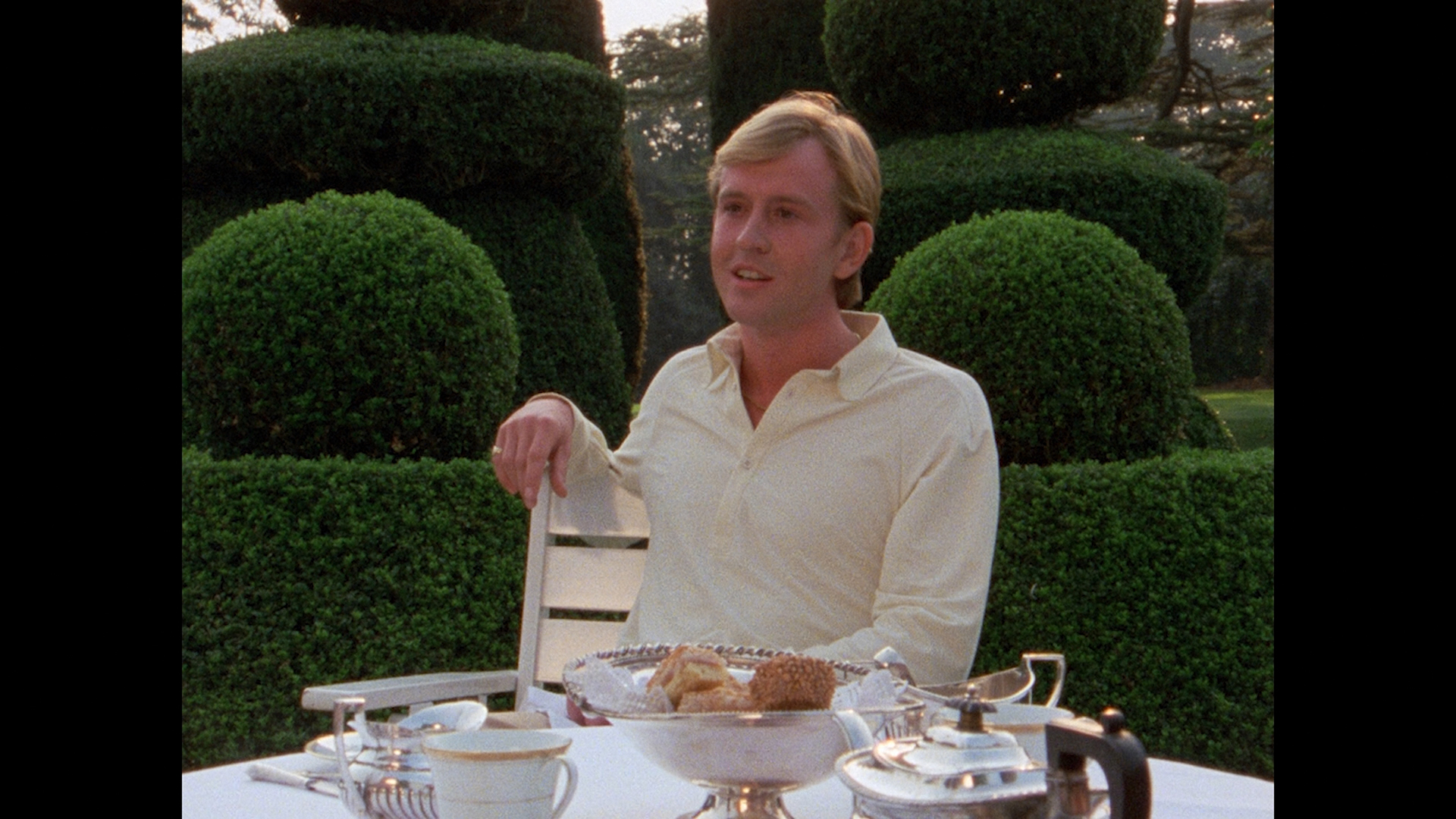 home video in any format until the BFI release, which was a godsend on DVD at the time.
home video in any format until the BFI release, which was a godsend on DVD at the time.
As for extras, Clark once again contributed entertaining video intros in which he talks about the background  behind the story choices and some of the more memorable moments of filming. The highlight is easily his discussion of working with Elliott, who was enthusiastic about the project and worked for less than his usual rate. However, he arrived without enough time to fully memorize his script, so cue cards had to be placed around the set for some of the more difficult scenes (which is why his eyes wander around a bit during some shots). As usual the liner notes provide plenty of valuable material about the source stories and films, with broadcaster Matthew Sweet doing an excellent job on The Signalman (including bits on Dickens' real-life train trauma and the tradition of railway ghosts), Dr. Helen Wheatley tackling Stigma (including an apropos reference to Angela Carter), Simon Farquhar's additional look at The Signalman as the close of Clark's BBC horror tenure, and Alex Davidson parsing out some of the mysteries behind the The Ice House.
behind the story choices and some of the more memorable moments of filming. The highlight is easily his discussion of working with Elliott, who was enthusiastic about the project and worked for less than his usual rate. However, he arrived without enough time to fully memorize his script, so cue cards had to be placed around the set for some of the more difficult scenes (which is why his eyes wander around a bit during some shots). As usual the liner notes provide plenty of valuable material about the source stories and films, with broadcaster Matthew Sweet doing an excellent job on The Signalman (including bits on Dickens' real-life train trauma and the tradition of railway ghosts), Dr. Helen Wheatley tackling Stigma (including an apropos reference to Angela Carter), Simon Farquhar's additional look at The Signalman as the close of Clark's BBC horror tenure, and Alex Davidson parsing out some of the mysteries behind the The Ice House.
27 years after putting the Ghost Story for Christmas annual series on ice, the BBC officially revived it again in 2005 with a new adaptation of a story by M.R. James. A View from a Hill is a simple story about young historian Dr. Fanshawe (Letheren) who borrows a pair of binoculars when his own get broken during a bike mishap on the way to curating an archaeological collection. The new pair once belonging to the late father of his host, and he finds he can see things in the lenses that don't appear in reality -- especially a strange abbey from his vantage point next to the sinister Gallows Hill. What is their secret, and why do the binoculars seem to open a window into the world of the dead? A credible attempt to revive the beloved TV tradition, this one manages to spark some of that old magic thanks to a few good shocks (especially the skull face gag), and the subdued but eerie ending wraps 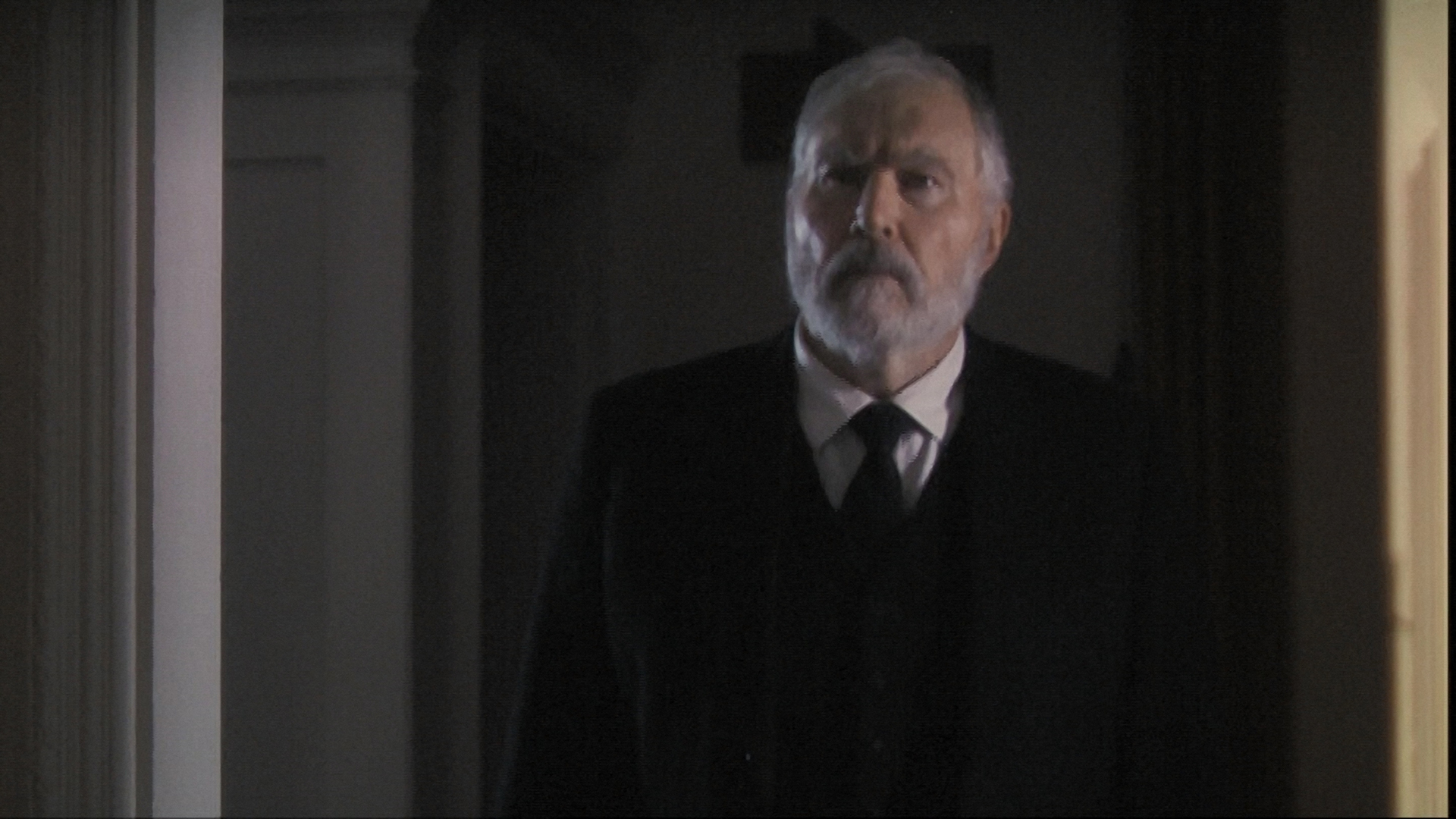 things up on a nice shuddery
things up on a nice shuddery  note. Lethern makes for another solid entry in the line of vulnerable, solitary men confronted by an inexplicable supernatural menace, and as usual the tension between the unseen dangers of the natural world and the false security of modern society make for a good backdrop.
note. Lethern makes for another solid entry in the line of vulnerable, solitary men confronted by an inexplicable supernatural menace, and as usual the tension between the unseen dangers of the natural world and the false security of modern society make for a good backdrop.
Like many other BBC productions around this time (notably the initial revival of Doctor Who), this was shot on standard definition 16:9 video, which was passable enough on DVD but definitely a huge step down compared to the shot-on-film textures of the prior entries. You'll see lots of edge halos and occasional video noise, flaws simply inherent in the way it's been shot. Like many of the previous entries, this made its official home video debut in an Australian DVD set of James adaptations, while the premiere UK video edition from the BFI in 2012 (also available as a standalone disc or part of a five-DVD set) is visibly taken from the same master. The stereo audio is modest but effective at times, particularly the harrowing pursuit through the woods.
The following year saw another new yuletide episode, this one adapted from the more familiar James story Number 13. Adorned with a mustache, the very good Greg Wise (who appeared in Sense and Sensibility and went on to marry Emma Thompson) takes charge here as the studious Professor Anderson, who causes some difficulty at his hotel when they can't seem to provide a room complete with both a comfortable bed and a good working desk. Finally he finds what he wants in Room 12, which is situated next to Room 14... with no number 13 between them. Another scholar had disappeared on the premises suddenly without paying his bill, so he has to pay upfront before beginning his work-- which takes him into a dark history involving witchcraft, local scandal, and Heironymous Bosch's painting, "The Garden of Earthly Delights." Most unsettlingly, in the middle of the night he hears disturbances... and when he walks outside, Room 13 is suddenly situated next door. What's inside the room, and can he unravel its mystery before the demonic danger inside claims him?
Though it makes some significant changes from the source story (including relocating the events from Denmark to the English countryside), this underrated tale is a very satisfying little bit of spookery that sits comfortably next to its predecessors. The evocative music score is a big plus as well, and while the little bonus twist at the end won't come as much of a shocker, the climax itself is a great piece of barnstorming terror, revealing just enough behind the door 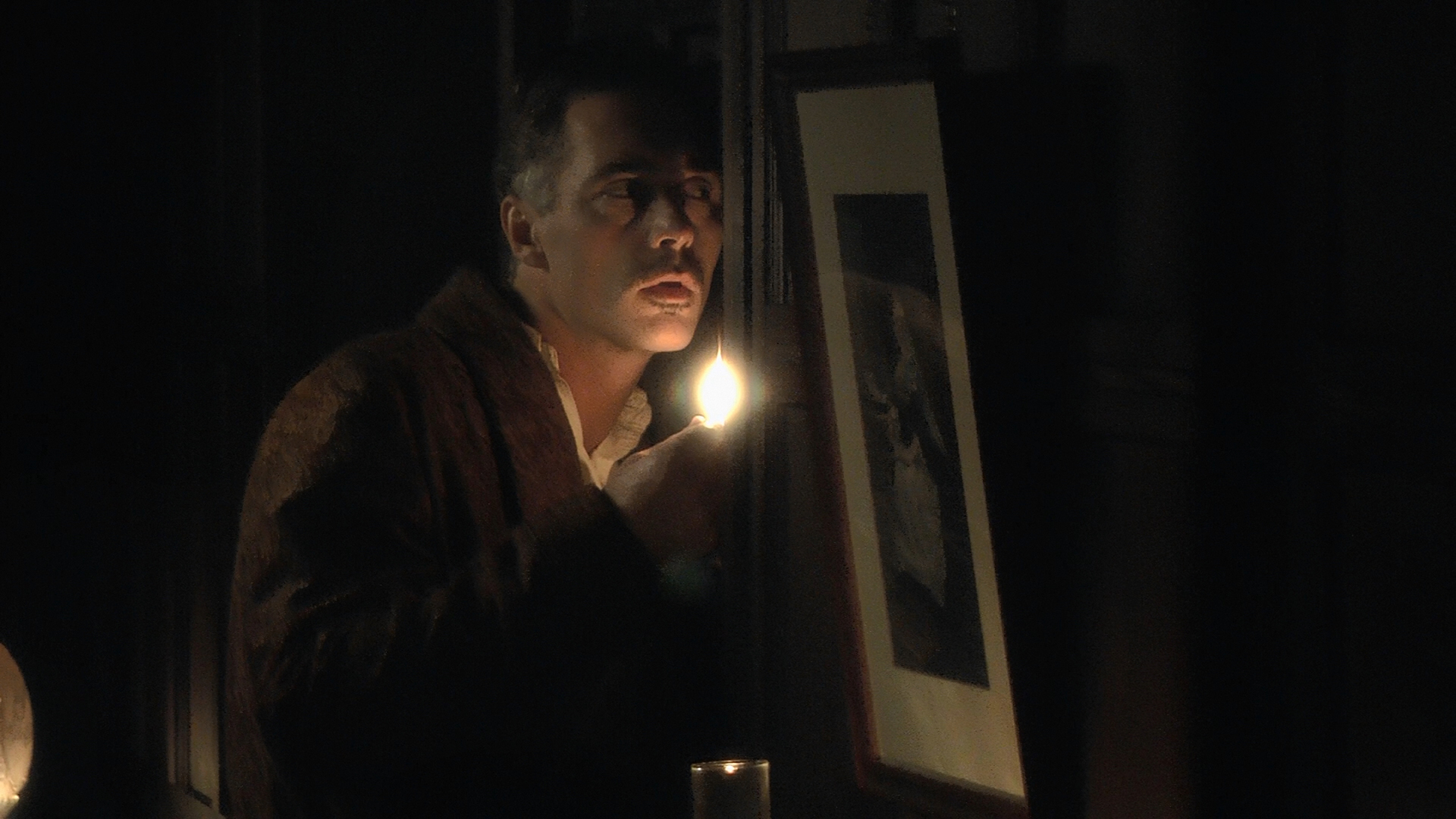 to the thirteenth room to have you looking nervously over your shoulder. The supporting cast is notable as well, including Paul Freeman (aka Belloq from Raiders of the Lost Ark) and a sympathetic turn from the always impressive Tom
to the thirteenth room to have you looking nervously over your shoulder. The supporting cast is notable as well, including Paul Freeman (aka Belloq from Raiders of the Lost Ark) and a sympathetic turn from the always impressive Tom  Burke as a librarian and the professor's sounding board for all the strange events, complete with an interesting homoerotic undercurrent that pays off with a nice chuckle at the end. Far more technically slick than A View from a Hill, this one was shot in HD with much richer, deeper blacks and far greater detail levels. It's still nowhere close to the quality of film, but the aesthetic bump is appreciated. That DVD only had one video extra this time around, but it's a great one: the "Number 13" adaptation from the four-episode, 2000 series, Ghost Stories for Christmas with Christopher Lee (a sort of unofficial offshoot with the horror legend reading and acting out M.R. James stories for an appreciative Edwardian-style audience). Lee has a fine time reading the story (whose much more faithful presentation here makes for a nice case study in contrast), and it also fits nicely with the previous two Lee readings in the prior sets. As usual, the hefty enclosed booklet includes an essay on "A View from a Hill" by Simon McCallum (who discusses both the source story and production in fine detail), a Jonathan Rigby piece on "Number 13" (which explains the budgetary reasons for some of the story changes), Reggie Oliver's bio of M.R. James, Robert Lloyd Parry's literate dissections of the two short stories, and a brief Rigby piece on the Christopher Lee version discussing some of the tasteful narrative adjustments.
Burke as a librarian and the professor's sounding board for all the strange events, complete with an interesting homoerotic undercurrent that pays off with a nice chuckle at the end. Far more technically slick than A View from a Hill, this one was shot in HD with much richer, deeper blacks and far greater detail levels. It's still nowhere close to the quality of film, but the aesthetic bump is appreciated. That DVD only had one video extra this time around, but it's a great one: the "Number 13" adaptation from the four-episode, 2000 series, Ghost Stories for Christmas with Christopher Lee (a sort of unofficial offshoot with the horror legend reading and acting out M.R. James stories for an appreciative Edwardian-style audience). Lee has a fine time reading the story (whose much more faithful presentation here makes for a nice case study in contrast), and it also fits nicely with the previous two Lee readings in the prior sets. As usual, the hefty enclosed booklet includes an essay on "A View from a Hill" by Simon McCallum (who discusses both the source story and production in fine detail), a Jonathan Rigby piece on "Number 13" (which explains the budgetary reasons for some of the story changes), Reggie Oliver's bio of M.R. James, Robert Lloyd Parry's literate dissections of the two short stories, and a brief Rigby piece on the Christopher Lee version discussing some of the tasteful narrative adjustments.
For the Blu-ray, the filmed episodes get a major upgrade equal to what was seen on the 2022 set. More image info is visible in the frame, colors are far richer and more varied, and detail is upped considerably, especially in the many, many dark scenes. The LPCM mono tracks also sound excellent and fuller than before, with optional English SDH subtitles. (The two more recent ones are 2.0 stereo.) Ported over here are the Christopher Lee Number 13 reading (29m20s) and the Clark introductions for The Treasure of Abbot Thomas (10m38s), The Ash Tree (8m5s), The Signalman (10m41s), and Stigma (8m44s). Likewise, the insert booklet features the essays by Alex Davidson, Dick Fiddy, Simon Farquhar and Helen Wheatley. Four very substantial new audio commentaries have been added here: The Treasure of Abbot Thomas by writer and TV historian Simon Farquhar, The Ash Tree by writer / TV historian Jon Dear, incorporating material from author and editor Johnny Mains, The Signalman by Dear and actor and writer Mark Gatiss (a big part of the rebooted series now), and Stigma and The Ice House by Kim Newman and Sean Hogan. Between them you get a very thorough history of the latter part of the '70s cycle, the contributions of Clark, the significant cast members, changes to the source stories, backstage changes at the BBC, and ties to other horror productions in the same decade. Also new here is "Spectres, Spirits and Haunted Treasure: Adapting MR James" (16m30s), a video essay by Nic Wassell looking at the visual approaches and literary conceits of the main James cycle starting with Whistle and I'll Come to You and going through The Ash Tree, pulling together numerous academic sources and clips to offer a rewarding look at how the writer's work was translated to another medium so successfully.
THE TREASURE OF ABBOT THOMAS (Blu-ray)

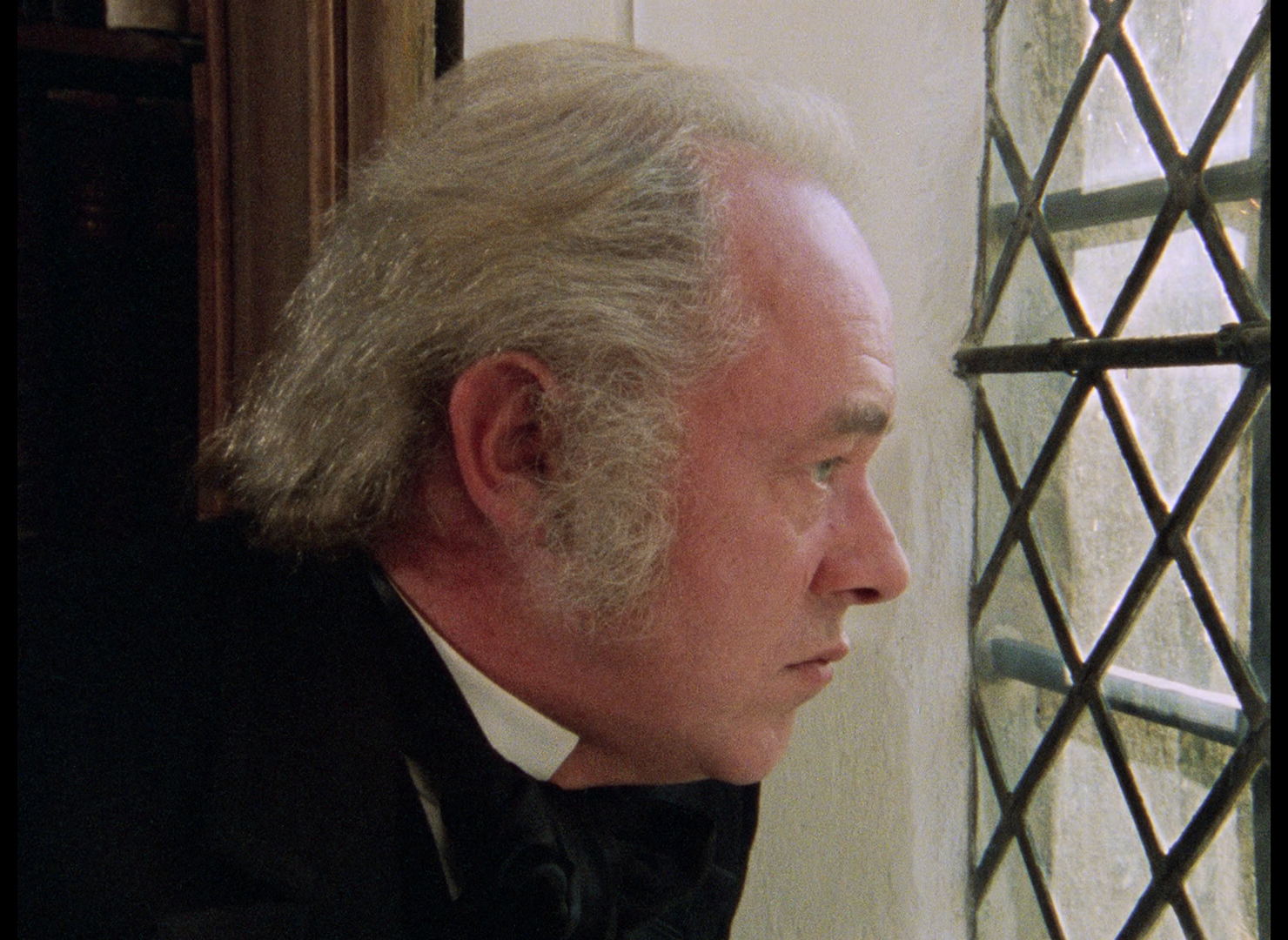

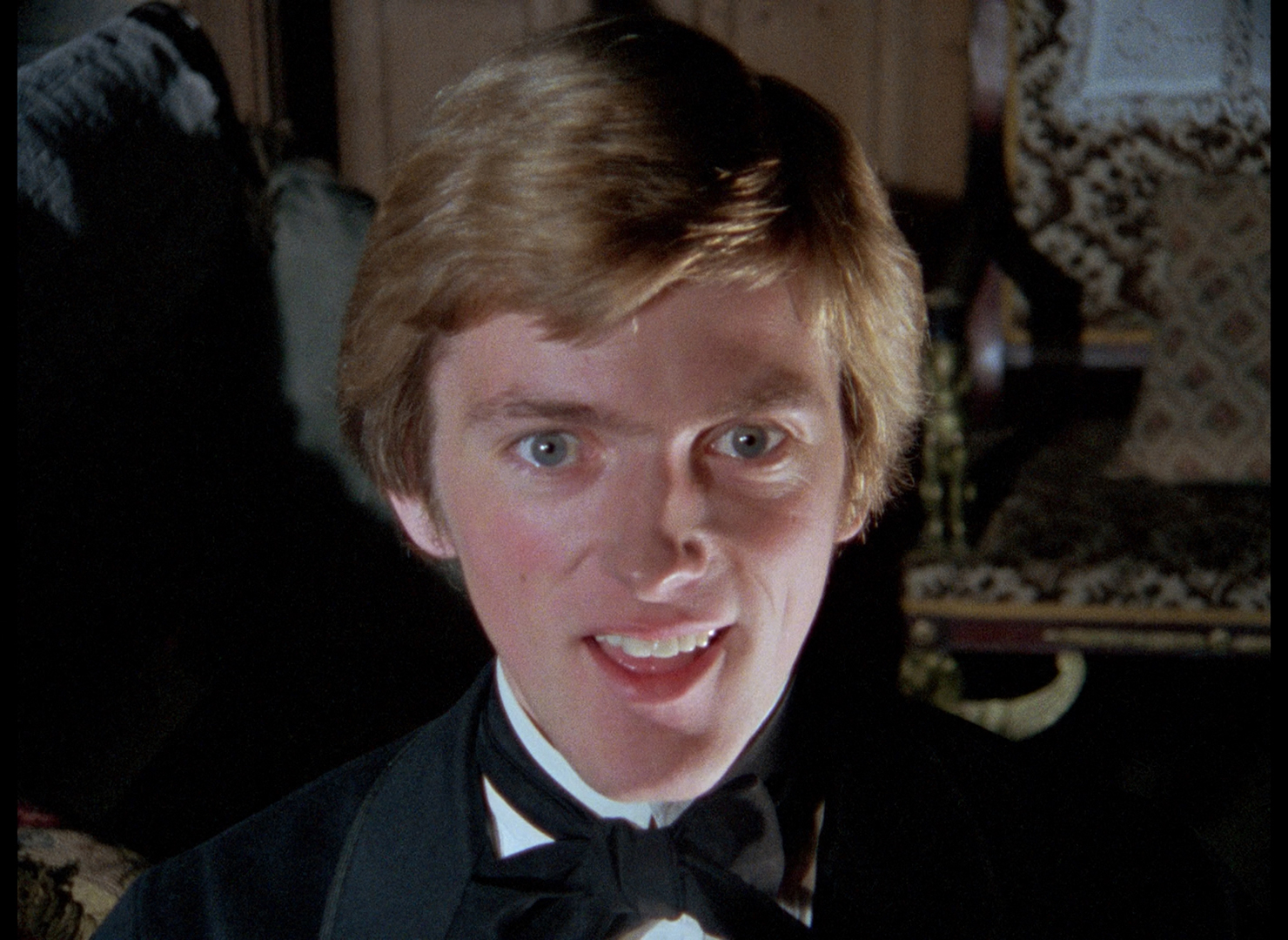
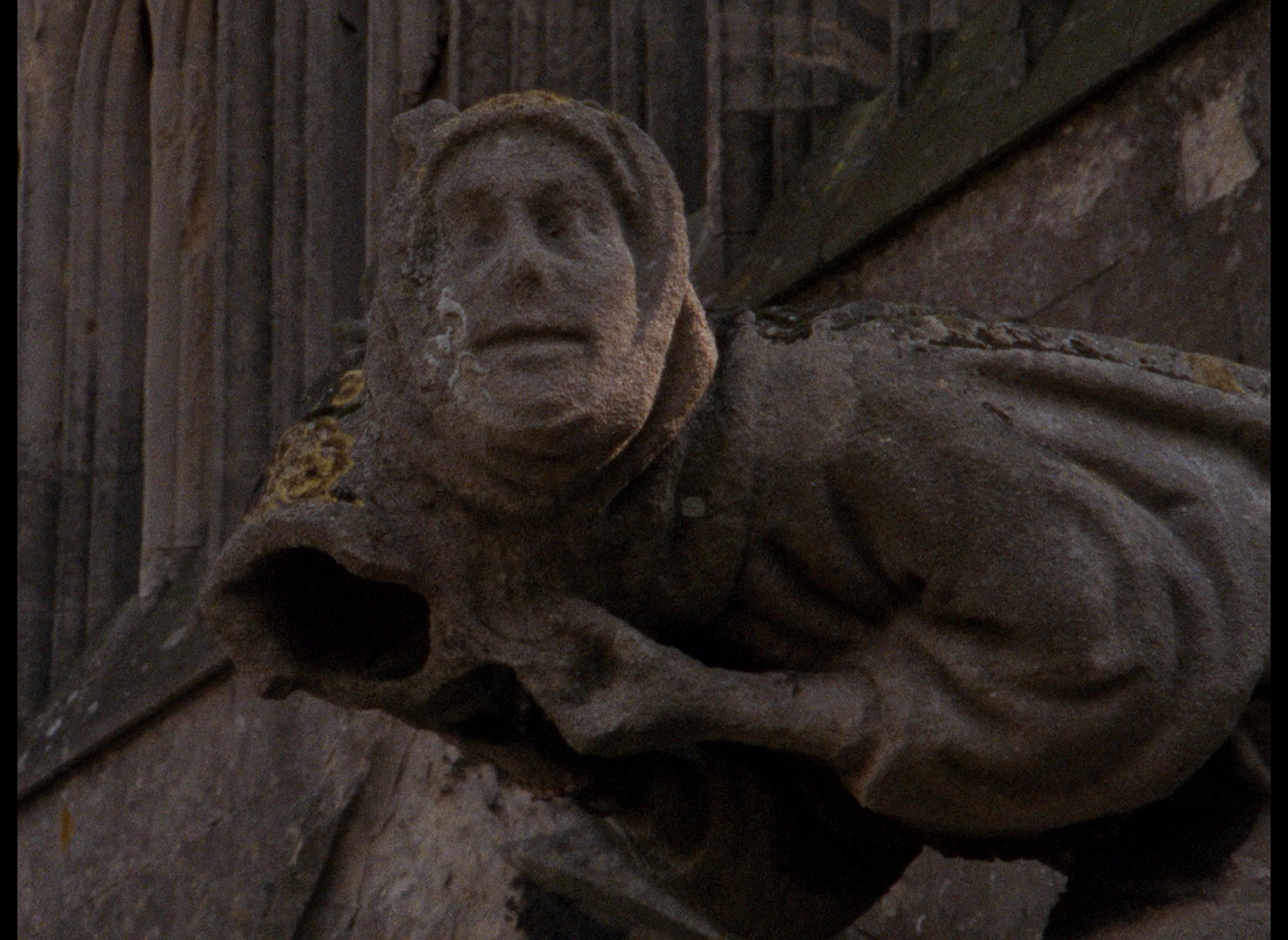
THE TREASURE OF ABBOT THOMAS (DVD)
Reviewed on November 28, 2023



 Blu-ray set, Ghost Stories for Christmas: Volume One, the BFI returned for the winter of 2023 with another
Blu-ray set, Ghost Stories for Christmas: Volume One, the BFI returned for the winter of 2023 with another  collection of the annual BBC spooky stories that defined U.K. small screen viewing in the '70s and made a welcome comeback in the current millennium. Here in Ghost Stories for Christmas: Volume Two, you get three prime era classics, a pair of unusual detours that closed out the series in its initial run, and the two episodes from the mid-'00s that kicked things back in gear again with entries now coming out in time for Christmas every year.
collection of the annual BBC spooky stories that defined U.K. small screen viewing in the '70s and made a welcome comeback in the current millennium. Here in Ghost Stories for Christmas: Volume Two, you get three prime era classics, a pair of unusual detours that closed out the series in its initial run, and the two episodes from the mid-'00s that kicked things back in gear again with entries now coming out in time for Christmas every year.  monastery grounds on which Somerton now resides. After much deciphering of Latin and breaking of codes, Somerton,
monastery grounds on which Somerton now resides. After much deciphering of Latin and breaking of codes, Somerton,  with the aid of Lord Peter, finally finds his way to an underground catacomb where a strange black slime seems to emanate from the treasure's location. But that's just the beginning of the horrors waiting in store for him...
with the aid of Lord Peter, finally finds his way to an underground catacomb where a strange black slime seems to emanate from the treasure's location. But that's just the beginning of the horrors waiting in store for him...  say fans of "The Zanti Misfits" from The Outer Limits will find an even more grotesque variation on that idea here.
say fans of "The Zanti Misfits" from The Outer Limits will find an even more grotesque variation on that idea here.  The always excellent Edward Petherbridge (who later went on to play Lord Peter Wimsey in a great trio of '80s UK TV mysteries) carries the show here as Sir Richard, a layabout who inherits the estate of his late uncle. Unfortunately, upon arrival he's haunted by dreams of his witch-hunting ancestor, Sir Matthew (Petherbridge again), whose bloodline was cursed by a hanged sorceress. Soon animals start dropping dead on the property, and the huge, seemingly impenetrable ash tree outside his window seems to play a larger role in the supernatural history of the house than anyone's letting on. This one's really all about the final five minutes, a dark, scary, fiery finale that probably sent the majority of its viewers rushing to flip on the lights after the credits rolled. Seeing so overtly monstrous and horrific in a James adaptation is still a bit surprising, and Clark wisely keeps things dim and shadowy enough to pack a punch within the confines of that familiar film stock.
The always excellent Edward Petherbridge (who later went on to play Lord Peter Wimsey in a great trio of '80s UK TV mysteries) carries the show here as Sir Richard, a layabout who inherits the estate of his late uncle. Unfortunately, upon arrival he's haunted by dreams of his witch-hunting ancestor, Sir Matthew (Petherbridge again), whose bloodline was cursed by a hanged sorceress. Soon animals start dropping dead on the property, and the huge, seemingly impenetrable ash tree outside his window seems to play a larger role in the supernatural history of the house than anyone's letting on. This one's really all about the final five minutes, a dark, scary, fiery finale that probably sent the majority of its viewers rushing to flip on the lights after the credits rolled. Seeing so overtly monstrous and horrific in a James adaptation is still a bit surprising, and Clark wisely keeps things dim and shadowy enough to pack a punch within the confines of that familiar film stock.  between eight to ten minutes apiece about how each short story was chosen and how he continued to maneuver around the network's perception of him as a documentarian. Some of the more important points include the switch to using a
between eight to ten minutes apiece about how each short story was chosen and how he continued to maneuver around the network's perception of him as a documentarian. Some of the more important points include the switch to using a  different screenwriter than himself for the first time and his insistence on using storyboards, but the best segment is easily the one for "The Ash Tree." He rattles off some great stories about how the production team couldn't find a suitable house with an ash tree in front of it (so they used reverse shots of the ash tree outside his own home thirty miles away from the main filming location) and how one of the monstrous beasties from the finale remained stuck in that tree long afterwards, much to the distress of passersby. The liner notes booklet includes an essay by the great Ramsey Campbell for "Lost Hearts" (in which he points out a few salient observations about changes to the story and the evocative use of fog), an Alex Davidson essay for "The Treasure of Abbott Thomas" (who considers several of the changes to the original text to be improvements), and Dick Fiddy's take on "The Ash Tree" (focusing on the script by playwright David Rudkin and the palpable sense of doom created by the performances). On top of that you get bios for James and Clark, an additional recap essay on all three by actor/writer Robert Lloyd Parry focusing strictly on their literary angle, and even a sample Abbott Thomas storyboard. Truly spooky, truly
different screenwriter than himself for the first time and his insistence on using storyboards, but the best segment is easily the one for "The Ash Tree." He rattles off some great stories about how the production team couldn't find a suitable house with an ash tree in front of it (so they used reverse shots of the ash tree outside his own home thirty miles away from the main filming location) and how one of the monstrous beasties from the finale remained stuck in that tree long afterwards, much to the distress of passersby. The liner notes booklet includes an essay by the great Ramsey Campbell for "Lost Hearts" (in which he points out a few salient observations about changes to the story and the evocative use of fog), an Alex Davidson essay for "The Treasure of Abbott Thomas" (who considers several of the changes to the original text to be improvements), and Dick Fiddy's take on "The Ash Tree" (focusing on the script by playwright David Rudkin and the palpable sense of doom created by the performances). On top of that you get bios for James and Clark, an additional recap essay on all three by actor/writer Robert Lloyd Parry focusing strictly on their literary angle, and even a sample Abbott Thomas storyboard. Truly spooky, truly  wonderful.
wonderful. By the mid-1970s, the annual TV ritual was bound to change after a succession of M.R. James adaptations. The 1976 entry was originally planned as James' "Count Magnus" (eventually filmed in 2022), but budgetary costs sent them searching for a new short story to adapt. The choice was made to tackle Charles Dickens' classic tale The Signalman, a short and chilling two-character piece that could easily be filmed in the English countryside with a minimum of actors. Fortunately the result, which kicks off the second Blu-ray, turned out to be one of the best in the series (in fact, it's a favorite of many), thanks in no small part to its sterling performance by Denholm Elliott and an underrated but effective one by TV actor Bernard Lloyd. It also didn't hurt that this was one of the earlier writing credits for Andrew Davies, who went on to write the terrific (and maddeningly still unavailable) BBC thriller Mother Love and the definitive version of Pride and Prejudice. (He also wrote the Bridget Jones movies, but everyone has to pay the rent.)
By the mid-1970s, the annual TV ritual was bound to change after a succession of M.R. James adaptations. The 1976 entry was originally planned as James' "Count Magnus" (eventually filmed in 2022), but budgetary costs sent them searching for a new short story to adapt. The choice was made to tackle Charles Dickens' classic tale The Signalman, a short and chilling two-character piece that could easily be filmed in the English countryside with a minimum of actors. Fortunately the result, which kicks off the second Blu-ray, turned out to be one of the best in the series (in fact, it's a favorite of many), thanks in no small part to its sterling performance by Denholm Elliott and an underrated but effective one by TV actor Bernard Lloyd. It also didn't hurt that this was one of the earlier writing credits for Andrew Davies, who went on to write the terrific (and maddeningly still unavailable) BBC thriller Mother Love and the definitive version of Pride and Prejudice. (He also wrote the Bridget Jones movies, but everyone has to pay the rent.)  of ensuring the safe passage of
of ensuring the safe passage of  trains, particularly through the long tunnel. However, the signalman has experienced persistent visions of a shadowy man calling out and holding his arm over his face. Twice before his visions have been followed by terrible accidents, such as a terrified bride being hurled off the passing train. Now his visions have returned with full force, and he fears something dreadful is imminent.
trains, particularly through the long tunnel. However, the signalman has experienced persistent visions of a shadowy man calling out and holding his arm over his face. Twice before his visions have been followed by terrible accidents, such as a terrified bride being hurled off the passing train. Now his visions have returned with full force, and he fears something dreadful is imminent. very satisfying detail levels.
very satisfying detail levels.  In a move that proved to be less than wise, the decision was made the following year to switch things to the present day and go with an original script not based on a short story. The result was Stigma by TV writer Clive Exton, a surprisingly intense and graphic bit of business that would still never come close to airing on prime time television in America. For the first time the focus here is not on men overtaken by the supernatural but a woman, in particular her body. Kate Binchy (who would next appear in the marvelous "Quiet as a Nun" installment of Armchair Thriller) stars as Katherine, who moves to a country home along with her husband, Paul (Bowles), and daughter Verity (Gordon). Some workmen are instructed to remove a large ancient stone in front of the house, part of a rock formation linked to a primitive sacrificial rite. As soon as the stone dislodges from the earth, a strong wind blasts both Katherine and Verity into near catatonia. Soon Katherine is plagued by uncanny events like blood seeping from her skin, fissures appearing in the walls and mirrors, and something rustling downstairs at night.
In a move that proved to be less than wise, the decision was made the following year to switch things to the present day and go with an original script not based on a short story. The result was Stigma by TV writer Clive Exton, a surprisingly intense and graphic bit of business that would still never come close to airing on prime time television in America. For the first time the focus here is not on men overtaken by the supernatural but a woman, in particular her body. Kate Binchy (who would next appear in the marvelous "Quiet as a Nun" installment of Armchair Thriller) stars as Katherine, who moves to a country home along with her husband, Paul (Bowles), and daughter Verity (Gordon). Some workmen are instructed to remove a large ancient stone in front of the house, part of a rock formation linked to a primitive sacrificial rite. As soon as the stone dislodges from the earth, a strong wind blasts both Katherine and Verity into near catatonia. Soon Katherine is plagued by uncanny events like blood seeping from her skin, fissures appearing in the walls and mirrors, and something rustling downstairs at night.  with enough prolonged
with enough prolonged  nudity and bloodshed to make one wonder whether they've accidentally stumbled into an episode of Hammer House of Horror instead. It's a harsh and downbeat piece of modern horror, one that will definitely entertain fans of the decade's move to more explicit terrors while probably blowing the minds of anyone unaware of what lies in store for them. The departure from the usual format took its toll, as this was apparently yanked from future broadcasts and became something of a black sheep among the series. It's quite a worthy addition on its own terms, though, particularly thanks to its decidedly feminine look at Cronenbergian body horror and all that entails. Women's lit students could have a field day with the symbolism in this one. For its worldwide home video debut, the BFI presented it on very solid ground in 2012 on DVD with a pretty good presentation from the only broadcast master around.
nudity and bloodshed to make one wonder whether they've accidentally stumbled into an episode of Hammer House of Horror instead. It's a harsh and downbeat piece of modern horror, one that will definitely entertain fans of the decade's move to more explicit terrors while probably blowing the minds of anyone unaware of what lies in store for them. The departure from the usual format took its toll, as this was apparently yanked from future broadcasts and became something of a black sheep among the series. It's quite a worthy addition on its own terms, though, particularly thanks to its decidedly feminine look at Cronenbergian body horror and all that entails. Women's lit students could have a field day with the symbolism in this one. For its worldwide home video debut, the BFI presented it on very solid ground in 2012 on DVD with a pretty good presentation from the only broadcast master around.  The result, which is set by itself on the third Blu-ray as the main attraction, is easily the most peculiar of the ghost story cycle, so oblique that it doesn't quite assert
The result, which is set by itself on the third Blu-ray as the main attraction, is easily the most peculiar of the ghost story cycle, so oblique that it doesn't quite assert  itself as a ghost story at all. The story begins with recently divorced, middle-aged Paul (The Omen's Stride) relaxing in a sauna at a country spa run by strange siblings Clovis (Burridge) and Jessica (Romilly). Strange details begin to pile up: many of the male guests seem freezing to the touch; the nearby ice house is decorated with a unique vine sprouting a pair of exotic and alluringly enormous blossoms; and the two owners seem to be... a little too close for comfort. One night Paul decides to explore the inside of the ice house, and what he finds inside accelerates his spiral into a supernatural vortex.
itself as a ghost story at all. The story begins with recently divorced, middle-aged Paul (The Omen's Stride) relaxing in a sauna at a country spa run by strange siblings Clovis (Burridge) and Jessica (Romilly). Strange details begin to pile up: many of the male guests seem freezing to the touch; the nearby ice house is decorated with a unique vine sprouting a pair of exotic and alluringly enormous blossoms; and the two owners seem to be... a little too close for comfort. One night Paul decides to explore the inside of the ice house, and what he finds inside accelerates his spiral into a supernatural vortex.  home video in any format until the BFI release, which was a godsend on DVD at the time.
home video in any format until the BFI release, which was a godsend on DVD at the time. behind the story choices and some of the more memorable moments of filming. The highlight is easily his discussion of working with Elliott, who was enthusiastic about the project and worked for less than his usual rate. However, he arrived without enough time to fully memorize his script, so cue cards had to be placed around the set for some of the more difficult scenes (which is why his eyes wander around a bit during some shots). As usual the liner notes provide plenty of valuable material about the source stories and films, with broadcaster Matthew Sweet doing an excellent job on The Signalman (including bits on Dickens' real-life train trauma and the tradition of railway ghosts), Dr. Helen Wheatley tackling Stigma (including an apropos reference to Angela Carter), Simon Farquhar's additional look at The Signalman as the close of Clark's BBC horror tenure, and Alex Davidson parsing out some of the mysteries behind the The Ice House.
behind the story choices and some of the more memorable moments of filming. The highlight is easily his discussion of working with Elliott, who was enthusiastic about the project and worked for less than his usual rate. However, he arrived without enough time to fully memorize his script, so cue cards had to be placed around the set for some of the more difficult scenes (which is why his eyes wander around a bit during some shots). As usual the liner notes provide plenty of valuable material about the source stories and films, with broadcaster Matthew Sweet doing an excellent job on The Signalman (including bits on Dickens' real-life train trauma and the tradition of railway ghosts), Dr. Helen Wheatley tackling Stigma (including an apropos reference to Angela Carter), Simon Farquhar's additional look at The Signalman as the close of Clark's BBC horror tenure, and Alex Davidson parsing out some of the mysteries behind the The Ice House.  things up on a nice shuddery
things up on a nice shuddery  note. Lethern makes for another solid entry in the line of vulnerable, solitary men confronted by an inexplicable supernatural menace, and as usual the tension between the unseen dangers of the natural world and the false security of modern society make for a good backdrop.
note. Lethern makes for another solid entry in the line of vulnerable, solitary men confronted by an inexplicable supernatural menace, and as usual the tension between the unseen dangers of the natural world and the false security of modern society make for a good backdrop. to the thirteenth room to have you looking nervously over your shoulder. The supporting cast is notable as well, including Paul Freeman (aka Belloq from Raiders of the Lost Ark) and a sympathetic turn from the always impressive Tom
to the thirteenth room to have you looking nervously over your shoulder. The supporting cast is notable as well, including Paul Freeman (aka Belloq from Raiders of the Lost Ark) and a sympathetic turn from the always impressive Tom  Burke as a librarian and the professor's sounding board for all the strange events, complete with an interesting homoerotic undercurrent that pays off with a nice chuckle at the end. Far more technically slick than A View from a Hill, this one was shot in HD with much richer, deeper blacks and far greater detail levels. It's still nowhere close to the quality of film, but the aesthetic bump is appreciated. That DVD only had one video extra this time around, but it's a great one: the "Number 13" adaptation from the four-episode, 2000 series, Ghost Stories for Christmas with Christopher Lee (a sort of unofficial offshoot with the horror legend reading and acting out M.R. James stories for an appreciative Edwardian-style audience). Lee has a fine time reading the story (whose much more faithful presentation here makes for a nice case study in contrast), and it also fits nicely with the previous two Lee readings in the prior sets. As usual, the hefty enclosed booklet includes an essay on "A View from a Hill" by Simon McCallum (who discusses both the source story and production in fine detail), a Jonathan Rigby piece on "Number 13" (which explains the budgetary reasons for some of the story changes), Reggie Oliver's bio of M.R. James, Robert Lloyd Parry's literate dissections of the two short stories, and a brief Rigby piece on the Christopher Lee version discussing some of the tasteful narrative adjustments.
Burke as a librarian and the professor's sounding board for all the strange events, complete with an interesting homoerotic undercurrent that pays off with a nice chuckle at the end. Far more technically slick than A View from a Hill, this one was shot in HD with much richer, deeper blacks and far greater detail levels. It's still nowhere close to the quality of film, but the aesthetic bump is appreciated. That DVD only had one video extra this time around, but it's a great one: the "Number 13" adaptation from the four-episode, 2000 series, Ghost Stories for Christmas with Christopher Lee (a sort of unofficial offshoot with the horror legend reading and acting out M.R. James stories for an appreciative Edwardian-style audience). Lee has a fine time reading the story (whose much more faithful presentation here makes for a nice case study in contrast), and it also fits nicely with the previous two Lee readings in the prior sets. As usual, the hefty enclosed booklet includes an essay on "A View from a Hill" by Simon McCallum (who discusses both the source story and production in fine detail), a Jonathan Rigby piece on "Number 13" (which explains the budgetary reasons for some of the story changes), Reggie Oliver's bio of M.R. James, Robert Lloyd Parry's literate dissections of the two short stories, and a brief Rigby piece on the Christopher Lee version discussing some of the tasteful narrative adjustments. 





